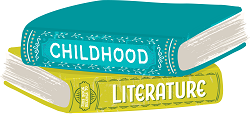Childhood Literature
Memories of authors and stories from the past.
by - Judie Weedon
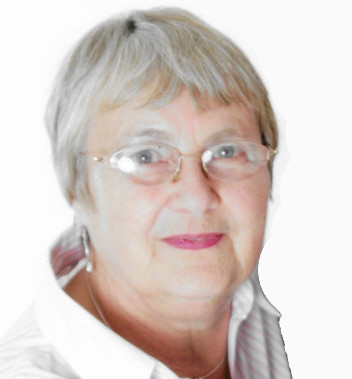
CHILDHOOD LITERATURE
"I can hate you more, but I'll never love you less." "Any problem can be solved between people if only they can trust each other" "cause when there's life there's still hope"
These quotes come, in a change from previous articles, from the work of a current day storyteller, Michael Morpurgo in his novel War Horse. Sir Michael Morpurgo is a British novelist, playwright, librettist and poet known for his many children's novels.
.jpg)
War Horse, The Play - Sydney Australia
Eva Rinaldi, CC BY-SA 2.0, via Wikimedia Commons
From 2003 to 2005 he was the Children's Laureate, receiving an OBE in 2006. He was appointed a knighthood in the 2018 New Year's Honour List for Literature and Charity. His latest book, There Once Is A Queen, illustrated by Michael Foreman, was published in 2022. But let Michael tell you more -
Much ado about . . . me
"I was born a really long time ago 5th October 1943 in St. Alban's in Hertfordshire. My mother was there too, strangely enough, but my father was away at the war, in Baghdad. I had one older brother, Pieter. We both were evacuated to Northumberland when we were little, away from the bombs. After the war it was all change at home, not that I remember much of it. My mother wanted to be with a man she had met while my father was away in the army. He was called Jack Morpurgo. So my father came home to find there was no place for him. There was a divorce. Jack Morpurgo married my mother, and so became our stepfather. We lived in London then. We went to primary school at St. Matthews in the Warwick Road, then were sent off to boarding school in Sussex - the Abbey, Ashurst Wood. I was there for six years, hated being away from home, loved rugby and singing. Then I went off to a school in Canterbury. The King's School, where I got more used to being away from home and still loved rugby and singing. We wore strange uniforms, wing collars, black jackets, boaters. And when I was older I got to wear a scarlet gown which made me feel very important.
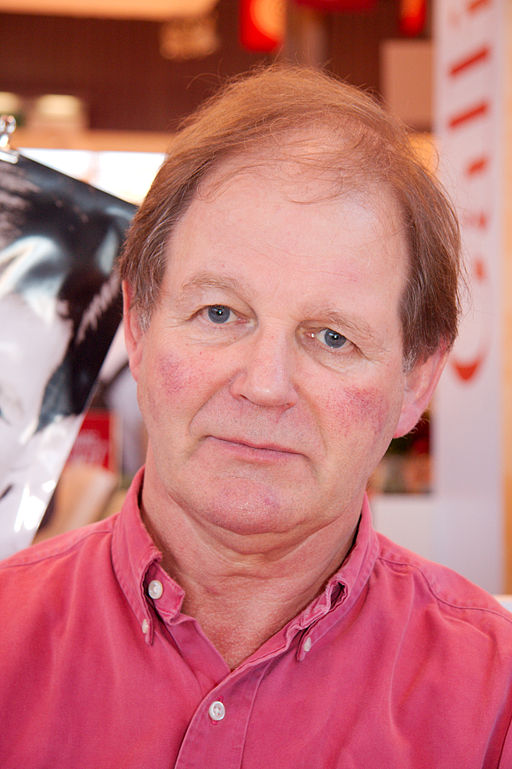
Michael Morpurgo
Georges Seguin (Okki), CC BY-SA 3.0
via Wikimedia Commons
I went into the army, to Sandhurst, where officers are trained. Liked the uniforms and the good food and the friends I made, but hated being shouted at. Decided the army life was not for me. Met a girl called Clare who agreed with me and we got married, really young, because we loved one another. Had children really young, three of them. Went off to university at King's College, London, to start all over again. I got my degree, just, and decided to be a teacher. I had done a little bit before and liked it. So found myself in front of a class of children for the first time. Scary! But I loved reading stories to them. They seemed to like that too. We moved around a lot from school to school, which was quite unsettling for everyone, but finally ended up teaching in a little village primary school in Kent, at Wickhambreaux, where I ran out of other writers stories to read, so started making up some of my own.
Then Clare and I decided to start all over again, again! She was a teacher too by this time. We thought that what children needed most were wonderful and memorable experiences that would really help them find out about the world around them and find out more about themselves too. So we set up a charity called Farms for City Children, moved to Iddesleigh, bought a big house called Nethercott where the children could stay, made a partnership with a farming family we had got to know and invited our first city children down to the farm. The charity has been running now for forty years. Over 90,000 children have come to the three farms where the charity now runs, in Wales at Lower Treginnis Farm, in Gloucestershire at Wick Court, and of course where we started it all, at Nethercott in Devon.
Clare and I worked at this for over twenty-five years, before handing it over to young, more energetic people, all wonderful people who run it now. The three farms still go on, with about 3,000 city and town children coming to stay with their teachers for a week working down on the farm. Clare and I remain involved but not out on the farm any more.
During all this time our children were growing up, of course. We now have eight grandchildren, with a great-grandchild on the way! And during all this time I was writing away, becoming a writer, a storyteller. Here in Devon I wrote nearly all my books, 130 I think, not that numbers count. And with all of them, I was much helped in my writing by many friends and writers, especially by Ted Hughes, the great poet, who lived nearby and fished on the river that runs through the farm. He became a good friend, and was a great inspiration to me to keep writing when I was finding it hard. And he and his wife Carol were always a source of great support to Farms for City Children.
Well that's just about all the much ado of my life, summed up in a nutshell. If you do want to find out more, then read Maggie Fergusson's biography of me, called War Child to War Horse.
Judie Weedon
42
CHILDHOOD LITERATURE
"But he isn't wearing anything at all!"

Hans Christian Andersen
by Christian Albrecht Jensen
Public domain, via Wikimedia Commons
The tale of two weavers promising an emperor a new suit of clothes that they say is invisible to all those who are stupid or incompetent, [except a small child], is the tale of the Emperor's New Clothes, one of the many fairy tales written by Danish author Hans Christian Andersen.
Andersen was born in Odense, Denmark on the 2nd April 1805. His parents, father Hans and mother Anne Marie - an illiterate washerwoman - were of poor means although they considered themselves belonging to a higher social class. It has been speculated but not proved, that Andersen was the illegitimate son of King christian VIII.
During the time when his father died in 1816 and his mother remarried two years later, Andersen attended a local school for poor children, receiving only a basic eduation and having to support himself as an apprentice to a weaver and later a tailor. At 14 he moved to Copenhagen seeking employment as an actor. He had an excellent soprano voice and was accepted into the Royal Danish Theatre, but his voice soon changed and he began to focus on writing, at first poetry. The Director of the Theatre, Jonas Collins, seeing his potential took him under his wing, sending him to a grammar school and persuading King Frederick VI to pay for part of his education.
Not a good student, he attended school at Elsinore until 1927. He later said that his school years were the darkest and most bitter years of his life, having suffered abuse from one schoolmaster in whose home he lived, who said this treatment was to 'improve his character'. He was discouraged to write, leading to depression.
_-_p.24.png)
The Emperor comes to see his new clothes
Henry Justice Ford
Public domain, via Wikimedia Commons
In the following years Andersen travelled extensively in Europe, his writings, especially his fairy tales, acheving publication and widespread success. His attention, in the 1840's, returned briefly to the Theatre but with little success. By 1845 he was celebrated throughout Europe, although his native Denmark showed some resistance to his self-importance.
His first visit to England was made in June 1847 when he enjoyed social success, meeting prominent people including Charles Dickens. The two authors, whose writings often depicted the hopeless poverty of the poor and underclass, respected each other's works.
Some ten years later, Andersen visited England again, primarily to meet Dickens, but he out stayed his welcome, his planned brief visit turning into a five-week stay, much to the distress of Dickens' family. After he was told to leave, Dickens gradually stopped all correspondence to the great disappointment and confusion of Andersen.
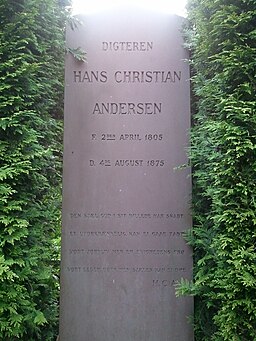
Grave, Copenhagen
Tahney, CC BY-SA 3.0
via Wikimedia Commons
Andersen's love life was diverse, having affairs with both male and female friends and falling in love with unattainable women. Riborg Voigt was the unrequited love of his youth. A letter from her was found on his chest when he died, several decades after he first fell in love with her and after he presumably fell in love with others.
In early 1872, when he was 67, Andersen severely hurt himself falling out of bed, from which he never really recovered, and shortly after started to show signs of liver cancer.
He died on the 4th August 1875 at the home of his friends Moritz Melchior and his wife. Shortly before his death, he had consulted a composer about the music for his funeral, saying: "most of the people who will walk after me will be children, so make the beat keep time with little steps."
He is buried at Assistens Cemetery in Copenhagen in a burial plot he originally shared with his friend and benefactor from the Royal Danish Theatre and his wife, but around 1920, a member of the Collin family had their tombstone moved, so that Han Christian Andersen's tombstone now stands alone.
The Emperor's New Clothes, The Little Mermaid, The Steadfast Tin Soldier, The Red Shoes, The Princess and the Pea, The Snow Queen [on which Disney's Frozen is loosely based], Thumbelina and The Ugly Duckling are some of the best known and loved of Hans Christian Andersen's fairy tales, 16l8 in all, many of which have been made into films and stage musicals.
Judie Weedon
29
CHILDHOOD LITERATURE
_at_Classic_&_Sports_Cars_By_the_Lake_(2010)_07.jpg)
Chitty Chitty Bang Bang
Martin Pettitt, CC BY 2.0, via Wikimedia Commons
"Never say 'No' to adventures. Always say 'Yes', otherwise you'll lead a very dull life."
This is the advice of Grandpa Potts whose son Caractucus, is a down-on-his-luck inventor who is persuaded by his two children Jeremy and Jermimer, to buy a car, used for racing in the European Grand Prix until it crashed in 1909. He names it Chitty Chitty Bang Bang for the unusual noise of its engine. So, together with the beautiful Truly Scrumptious, their adventures begin.
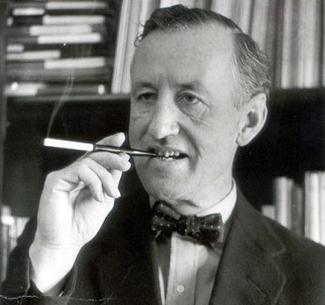
Ian Lancaster Fleming
By Unknown - Original. Publication: Unknown
Immediate source, Fair use, Link
Chitty Chitty Bang Bang is a children's book, 1968 musical fantasy film and a stage show, familiar to many families, but did you realise it was written by Ian Fleming of James Bond fame?
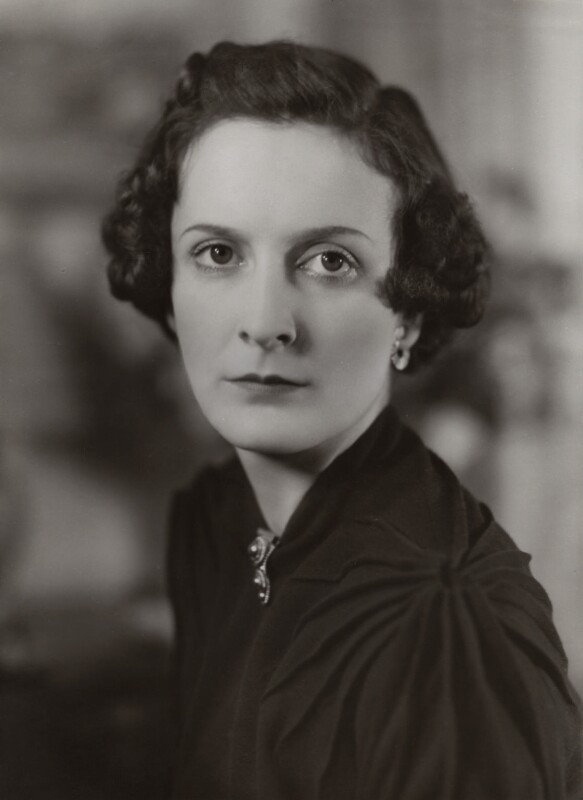
Anne Geraldine Fleming
by Bassano Ltd
bromide print, October 1937
Purchased, 1996
NPG x83901
© National Portrait Gallery, London
Licenced under CC BY-NC-ND 3.0
Ian Lancaster Fleming [1908-1964] a British writer, journalist and naval intelligence officer, was born in Mayfair, London, on the 28th May, 1908, the son of Evelyn [Rose] and Valentine Fleming.
His father was the Member of Parliament for Henley and rising to the rank of Major with the Queen's Own Oxfordshire Hussars in the First World War. He was killed in action on the Western Front in May 1917.
Fleming had three brothers: Peter [1907-1971], the eldest, was a travel writer who married the actress Celia Johnson [Brief Encounter] in 1935; Richard [1911-1977] was a highly successful travel writer, later turning his hand to thrillers, and Michael [1913-1940] who died of wounds whilst serving with the Oxfordshire & Buckinghamshire Light Infantry in World War II. He also had a younger half-sister, Amaryllis [1920-1999] whose father was the artist Augustus John, who had a long-term affair with his mother following the death of his father.
Fleming's education was somewhat chequered, Not enjoying his early school days, suffering physical hardship and bullying, he went to Eton College in 1921, where he failed to achieve academically but excelled at athletics, leaving under a cloud due to his wayward life style. Following this he attended a private school in Austria and studied briefly at the universities of Munich and Geneva.
His service in the Second World War was far more commendable. He served in Britain's Intelligence Division, involved in the planning of Operation Goldeneye and in planning and oversight of two intelligence units, 30 Assault Unit and T-Force. His wartime service and his career as a journalist provided much of the background, detail and depth of the James Bond novels.
After the war he became the foreign manager in the Kemsley newspaper group, which at the time owned the Sunday Times. His role oversaw the paper's worldwide network of correspondents. His contract allowed him to take three months holiday every winter, which he spent in Jamaica. He continued to work for them until the end of 1959, keeping in touch until 1964.
Fleming's love-life was as chequered as his education! A long-term affair with Ann Charteris ended when he decided he would remain a bachelor and she then married her second husband, Viscount Rothermere. However, the affair with Fleming continued and in 1951 her husband divorced her on grounds of adultery. In 1952, in Jamaica, Fleming and Ann married, their son Caspar was born later that year. Throughout their marriage, both indulged in extra-marital affairs.

Goldeneye, Fleming's home in Jamaica
Banjoman1, CC BY-SA 3.0, via Wikimedia Commons
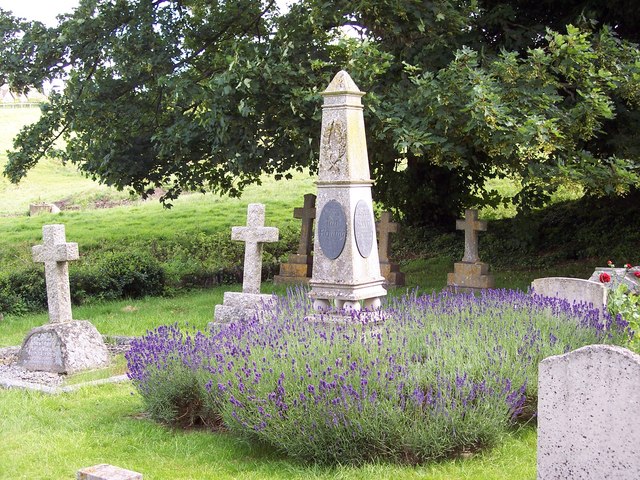
The family grave at Sevenhampton
Trish Steel, CC BY-SA 2.0, via Wikimedia Commons
The first Bond novel, Casino Royale, was written in 1952, thirteen more were to follow up to Fleming's death. The first to be filmed was Dr. No in 1962.
Fleming was a bird-watcher and having read the book The Birds of the West Indies written by ornithologist James Bond, he borrowed the name because it was the 'dullest' name he could think of! Goldeneye, the name of his home and estate in Jamaica, is also a birding reference as well as the operation in which he was involved during the war.
Fleming's health had never been good, not helped by his lifestyle. At 38, complaining of chest pains, he informed a startled doctor that he consumed a bottle of gin and 70 cigarettes a day! In 1961 he suffered a massive heart attack from which he never really recovered. On the eve of Caspar's 12th birthday, after dining out lunch and dinner with friends, he suffered another heart attack, dying the following morning in the Kent and Canterbury Hospital on the 12th August 1964. His estate was valued at £302,147 - equivalent in 2020 to £6,259,844.
Fleming is buried at Sevenhampton, near Swindon, together with Caspar who died of an overdose in 1981 and Ann who died in July 1981.
Judie Weedon
39
CHILDHOOD LITERATURE
Rats!
It is said that if you watch enough horror movies, sooner or later you'll hear the phrase 'Every legend has a basis in fact.'
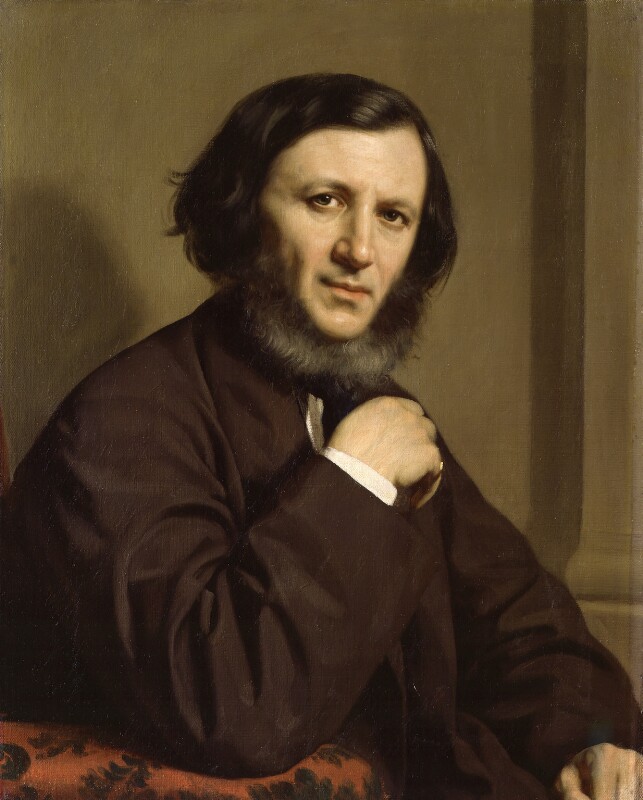
Robert Browning
by Michele Gordigiani
oil on canvas, 1858
Given by Florence L. Barclay (née Charlesworth), 1921
NPG 1898
© National Portrait Gallery, London
Licenced under CC BY-NC-ND 3.0
Surely most have encountered at some time the chilling legend/story of the Pied Piper of Hamelin, which dates back to the Middle Ages and is possibly based on fact, when the town of Hamelin was overrun by a plague of rats. A stranger, wearing multi-coloured, or pied, clothing offered to rid the town of rats in exchange for a payment. The stranger then played a tune on his pipe at which the rats followed him out through the gates of the town and drowned in the river. Seeing how easily they had been cleared of the rats, the townsfolk reneged on the deal. Seeking revenge, the piper returned and again played his pipe, this time the children danced and followed him, all except one lame, little boy, unable to keep up as the children disappeared never to be seen again.
The Pied Piper of Hamelin
Hamelin Town's in Brunswick,
By famous Hanover city;
The River Weser, deep and wide,
Washes its wall on the southern side;
A pleasanter spot you never spied;
But, when begins my ditty,
Almost five hundred years ago,
To see the townsfolk suffer so
From vermin, was a pity.
The tale has been told and retold including by Johanne Wolfgan von Goethe, who incorporated the story into his famous play Faust and it has even appeared in sequels of Shrek! But possibly the most well-known and quoted above, was by the English poet and playwright Robert Browning.
Robert Browning was born in Walworth, near Camberley, Surrey, on the 7th May 1812, the only son of Sarah and Robert Browning, a well to do Bank of England Clerk. His parental grandfather was a slave owner in St. Kitts, West Indies, but his father was an abolitionist. His mother was the daughter of a German shipowner who had settled in Dundee with his Scottish wife.
Robert, and his younger sister Sarinnia, grew up in a household with significant literary resources, their father having amazed a library of about 6,000 books, many of them rare. Their mother, to whom Robert was close, was a devout non-conformist and a talented musician.
By the time he was 12, Robert had written a book of poetry, but unable to find a publisher, he destroyed it. His education was unusual. Having shown an abhorrence to school life at two private schools, he was educated at home by a tutor. His father's library a valuable resource, by 14 he was fluent in French, Greek, Italian and Latin. He admired the Romantic poets, especially Shelley, whom he followed in becoming an atheist and a vegetarian.
At 16 he studied Greek at University College London, leaving after his first year. Due to his parents' evangelical faith, he was barred from studying at Oxford or Cambridge, which at that time were only open to members of the Church of England. He had inherited good musical ability from his mother and composed arrangements of various songs.
He refused a formal career, ignoring his parents by concentrating on his poetry, and staying at home until was 34, financially dependent upon his parents, his father sponsoring the publication of his poems, until his marriage.
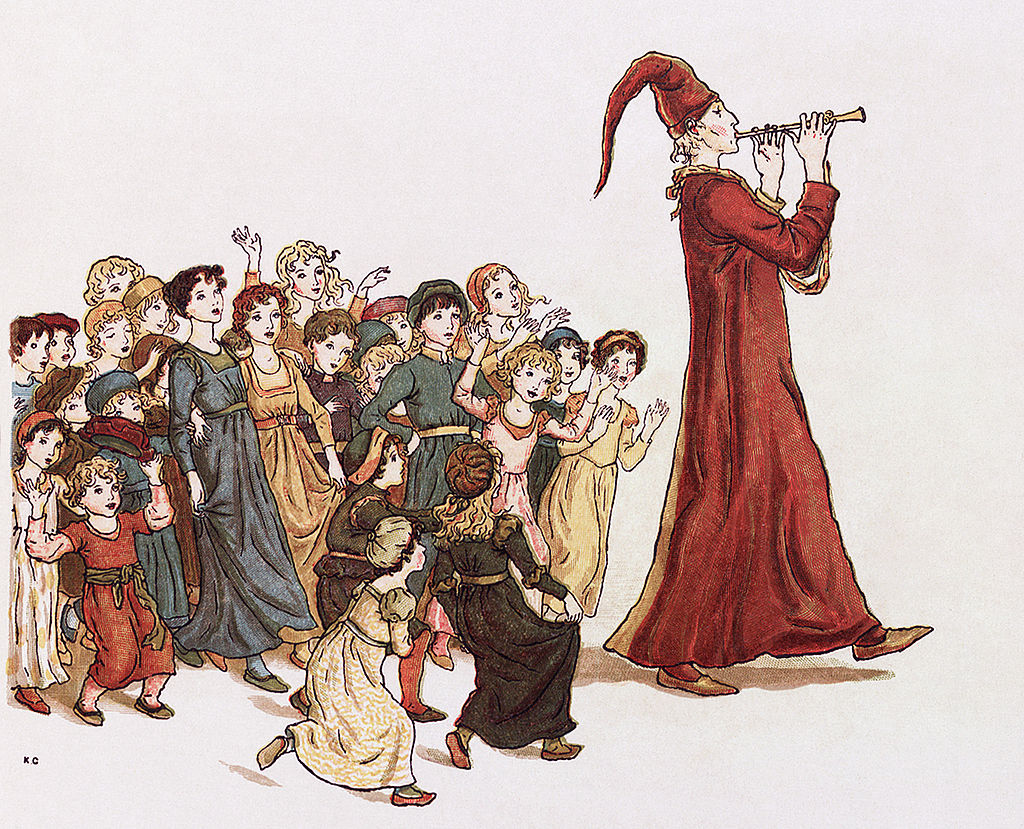
Illustration from The Pied Piper of Hamelin -
Edmund Evans [1826-1905]
Public domain, via Wikimedia Commons
In 1845 Browning met the poet Elizabeth Barrett, six years his senior, a semi-invalid who lived with her father in Wimpole Street. Corresponding regularly, a romance developed and they married, in secret - her domineering father disapproved of marriage for any of his 12 children - on the 12th September 1846, and journeyed to Italy to help Elizabeth's health. Elizabeth was herself an eminent Victorian poet and, on the death of William Wordsworth, was a serious contender for the post of Poet Laureate, the position eventually going to Tennyson.
Throughout their married life, the Brownings remained in Italy, first in Pisa and then Florence. Their only child, following many miscarriages, a son also called Robert, but nicknamed Pen, was born in 1849.
As Elizabeth had inherited money of her own, they were comfortably well off and happy. But Browning's work was critically dismissed, particularly by Charles Kingsley and others for his desertion of England for foreign lands.
Browning identified as a Liberal, supported the emancipation of women and opposed slavery. He later championed the rights of animals and was a stalwart opponent of anti-Semitism, leading to speculation that he was in fact Jewish.
Elizabeth's poor health plagued her throughout her life and she died in Florence, in her husband's arms, on the 29th June 1861, and is buried in the English Cemetery of Florence.
In his remaining life, Browning travelled extensively. In 1878 he revisited Italy for the first time since Elizabeth's death, returning there on several occasions. During this time, his sister Sarianna, became his companion. He died in Venice on the 12th December 1889 and is buried in Poets' Corner in Westminster Abbey, now immediately adjacent to the grave of Alfred Lord Tennyson.

Home Thoughts from Abroad
O, to be in EnglandNow that April's there,
And whoever wakes in England
Sees, some morning, unaware,
That the lowest boughs and the brushwood sheaf
Round the elm-tree bole are in tiny leaf,
While the chaffinch sings on the orchard bough
In England - now!
And after April, when May follows,
And the whitethroat builds, and all the swallows!
Hark, where my blossom'd pear-tree in the hedge
Leans to the field and scatters on the clover
Blossoms and dewdrops - at the bent spray's edge -
That's the wise thrush; he sings each song twice over,
Lest you should think he never could recapture
The first fine careless rapture!
And though the fields look rough with hoary dew,
All will be gay when noontide wakes anew
The buttercups, the little children's dower
- Far brighter than this gaudy melon-flower!
Robert Browning 1845

Illustrations by: Paul Swailes
Judie Weedon
39
CHILDHOOD LITERATURE
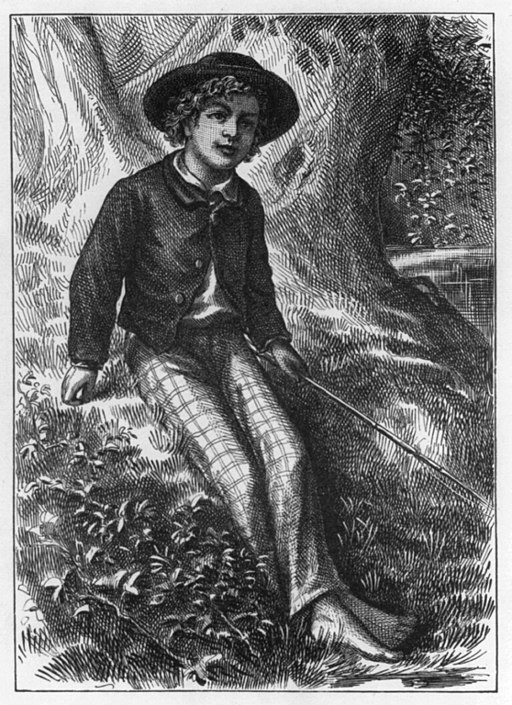
Cover - The Adventures of Tom Sawyer
[1st edition 1876]
By True Williams [1839-1897]
Public domain, via Wikimedia Commons
"Tom said to himself that it was not such a hollow world, after all. He had discovered a great law of human action, without knowing it - namely, that in order to make a man or a boy covet a thing, it is only necessary to make the thing difficult to attain."
The Adventures of Tom Sawyer is an 1876 novel by Mark Twain about a boy growing up along the Mississippi River. Tom has several adventures, often with his friend, Huckleberry Finn. Originally a commercial failure, the book finished up being the best-selling of any of Twain's works during his lifetime. Considered to be a masterpiece of American literature, it was one of the first novels to be written on a typewriter.
Samuel Langhorne Clemens, known by his pen name Mark Twain, was born on the 30th November 1835, in Florida, Missouri, the sixth of the seven children of John [1798-1847] and Jane [1803-1890]. He was of English [Cornish] and Scots-Irish descent. Sadly, he and only 3 of his siblings survived beyond childhood.
When Twain was 4, the family moved to Hannibal, Missouri, on the Mississippi River, a port town that inspired the fictional St.Petersburg in his books, at a time when slavery was legal in Missouri.
Following his father's death of pneumonia, Twain left school in the fifth grade, and began work as an apprentice typesetter, often contributing articles in the Hannibal Journal. He left Hannibal when he was 18, working as a printer in New York, Philadelphia, St. Louis and Cincinnati, joining the printers' trade union, educating himself in public libraries in the evenings.
The one ambition of his boyhood friends and himself, living by the Mississippi, was to be a steamboat man, and to be a Pilot was the best position of all. Following this ambition, Twain was taken on as a cub-pilot by Horace Bixby, who taught him the river between New Orleans and St. Louis. Twain studied the Mississippi, learning its landmarks, how to navigate its currents and how to read the river and its constantly shifting channels, reefs, submerged snags and rocks that would damage the strongest of vessels. It took more than two years before he got his pilot's licence. Piloting gave him his pen name, from 'mark twain' the cry for a measured river depth of two fathoms [12 feet] which was safe water for a steamboat. He continued to work on the river until 1861 when the Civil War broke out.
After travelling west, becoming a miner in Virginia City, a job he failed at, he turned to journalism, where he met with some publishing success, using his pen name for the first time in 1863 on a humorous travel account.
On a newspaper funded trip to the Mediterranean in 1867, he befriended a fellow passenger, Charles Langdon, who showed him a picture of his sister Olivia. Twain later claimed he had fallen in love at first sight!
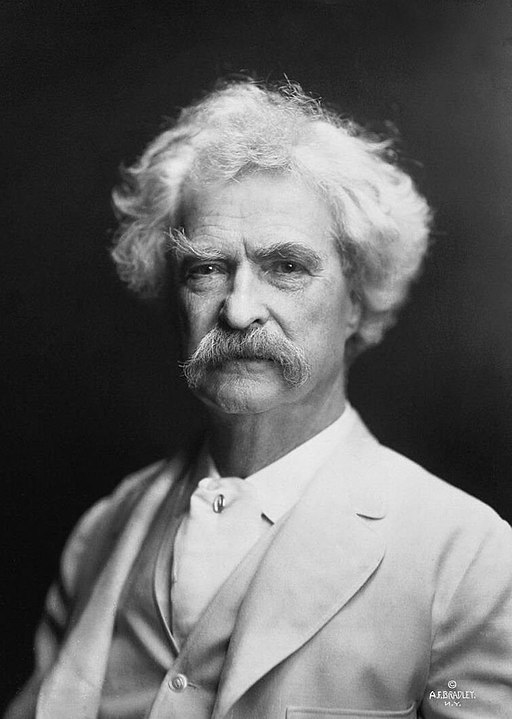
Mark Twain
A.F. Bradley, New York
Public domain, via Wikimedia Commons
After corresponding with each other, and having rejected his first proposal of marriage, Olivia and Twain were married in New York in February 1870. She came from a 'wealthy but liberal' family and through her, Twain met many influential abolitionists, socialists, atheists and activists, including Harriet Beecher Stowe.
For a couple of years, 1869-1871, they lived in Buffalo, New York, during which time they lost their only son Langdon from diphtheria when he was 19 months old. There followed three daughters; Susy [1872-1896], Clara [1874-1962] and Jean [1880-1909].
Twain lived live to the full. His interests, other than writing and journalism, were many and varied. He was fascinated by science and scientific inquiry, he patented three inventions - a history trivia game, detachable straps for garments [to replace suspenders], and a self-pasting scrapbook, the pages of which had a self-pasting adhesive when dampened of which over 25,000 sold. He was an early advocate of fingerprinting as a forensic technique. He was also in great demand as a speaker, performing solo humorous talks similar to today's stand-up comedy, all over the world, including England, London.
Like his father before him, Twain was a poor businessman, both making money and losing it, declaring bankruptcy following the failure of the Paige typesetting machine in which he had invested heavily. In 1891 the family moved from their expensive home in Hartford, moving to Europe, living in France, Germany, Italy and England, mainly in London. But, having the ability to pay off his debts, the family returned to America in October 1900.
Twain's later life was spent in Manhattan. From 1896 he suffered a long period of serious depression which began with the death, of meningitis, of his daughter Susy, followed by the death of Olivia in 1904 and Jean in 1909, as well as a very close friend in 1906.
In 1907, Twain was awarded an honorary Doctorate of Letters [D. LItt.] by the University of Oxford.
Twain was born two weeks after Halley's Comet's closest approach in 1835, and in 1909 he said: "I came in with Halley's Comet. It is coming again next year, and I expect to go out with it. It will be the greatest disappointment of my life if I don't go out with Halley's Comet. The Almighty has said, no doubt: "Now here are these two unaccountable freaks, they came in together, they must go out together."
His prediction was accurate, Twain died of a heart attack on the 21st April 1910, in Stormfield, his home in Redding, Connecticut, one day after the comet's closest approach to earth.
Judie Weedon
35
CHILDHOOD LITERATURE
"God bless Aunt Miranda! God bless the brick house that was! God bless the brick house that is to be!" These words exclaimed by Rebecca conclude the classic American 1903 children's novel, Rebecca of Sunnybrook Farm, written by Kate Douglas Wiggin.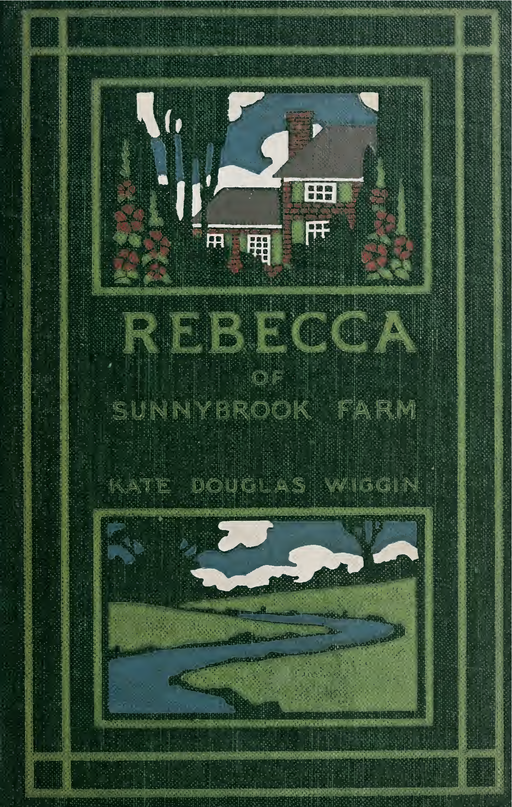
Cover from 1903
Kate Douglas Wiggin
Public domain, via Wikimedia Commons
Kate Douglas Smith Wiggin was born in Philadelphia on the 28th September 1856, the daughter of a lawyer of Welsh descent, Robert Smith. She had a happy childhood although her father died when she and her sister, Nora, were only small. Following her husband's death, their mother moved the family to Portland, Maine and then three years later, on her remarriage to Albion Bradbury, to the village of Hollis in Maine.
When Kate was 11, Charles Dickens was reading on tour in the States, but Kate was thought to be too young to warrant an expensive ticket to hear him. However, on the following day she found herself on the same train as Dickens and apparently engaged him in a lively conversation for the course of the journey! This experience is detailed in a memoir, A Child's Journey with Dickens [1912].
Kate's education was somewhat irregular, including home instruction from her step-father, and graduating from the Abbot Academy in Andover, Massachusetts, in 1873. Although casual, hers was more education than most girls received at that time.
In the same year, hoping to ease Albion's health, he suffered from lung disease, the family moved to Santa Barbara, California, where he died just three years later.
A kindergarten training class opened in Los Angeles and Kate enrolled. Graduating in 1878, she became head of the first free kindergarten in California, in the slums of Silver Street, San Francisco. The children were, to quote, children of the wildest type, but Kate's loving personality and flair won them over and by 1880 she was forming a teacher training school at the Silver Street Kindergarten.
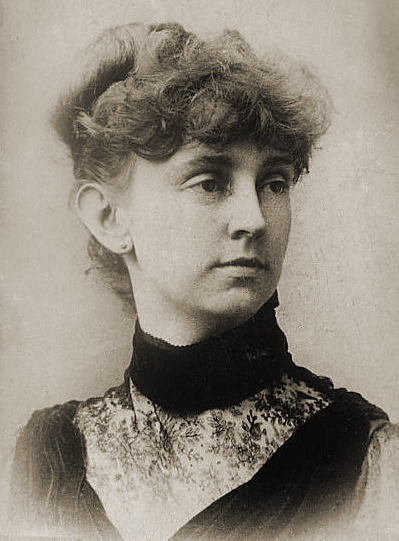
Kate Douglas Wiggin
Bain Collection, Public domain
via Wikimedia Commons
In 1881 Kate married Samuel Bradley Wiggin, a San Francisco lawyer, but as was customary at the time, it was necessary for her to resign from her job. However, devoted to her school, she began to raise money for it by writing stories - the first The Story of Patsy [1883] was followed by more with enormous success.
The couple had no children and in 1888 they moved to New York City. Bradley died suddenly a year later and Kate relocated to Maine. It is believed that for the rest of her life she grieved, but consoled herself by travelling frequently and extensively, dividing her time between writing and public reading for the benefit of various children's charities.
Making three trips to the UK in three years, 1892, 1893 and 1894, records from the Ellis Island docking logs show that at first, although a widow, she described herself 'wife', but in 1894 as 'authoress'.
On her way to England in 1894, Kate met George Christopher Riggs, a linen importer, and it is said that having got on so well, they had agreed to marry before docking in Liverpool. They married in New York on the 30th March 1895.
Kate continued to write many and varied books under the name of Wiggin, writing the immediate best-seller classic children's novel Rebecca of Sunnybrook Farm in 1903, followed by another best-seller, Rose o' the River in 1905.
Kate was a popular hostess in New York and in Upper Largo, Scotland, where she had a summer home, and where for many years she organised plays.
During the spring and summer of 1923, whilst in England as a New York delegate to the Dickens Fellowship, Kate became ill with bronchial pneumonia, dying in Harrow, Middlesex, on the 24th August. At her request, her ashes were taken back to Maine and scattered over the Saco River.
Wiggin was also a songwriter and composer, writing some of the lyrics, music and arrangements, composing all the music for Nine Love Songs and a Carol [1896].
Many of her novels were made into films, the most famous one being the 1938 film of Rebecca of Sunnybrook Farm starring Shirley Temple.
Judie Weedon
35
CHILDHOOD LITERATURE
'It had been an unhappy day for little
Kay Harker.To begin with, at breakfast
time the governess had received a letter from his guardian, Sir Theopompous,
the chemical powder merchant, to say that he would be there for lunch, but
would like lunch at 2 p.m., as the trains did not suit.This made the governess cross, or, as she
called it, 'put out'.On giving the
order to Jane, the cook, for a very good lunch at two o'clock, instead of one,
Jane was put out, for it was her afternoon off and she did not like to be put
upon.Ellen, the maid, was also put
out, because if you have lunch so late, it is teatime before you have finished
washing up. Jane and Ellen between them
put the governess much further out, and then it was lesson time:Divinity, French, History and Latin.
Kay's magical adventures seeking his
great-grandfather's lost treasure start.
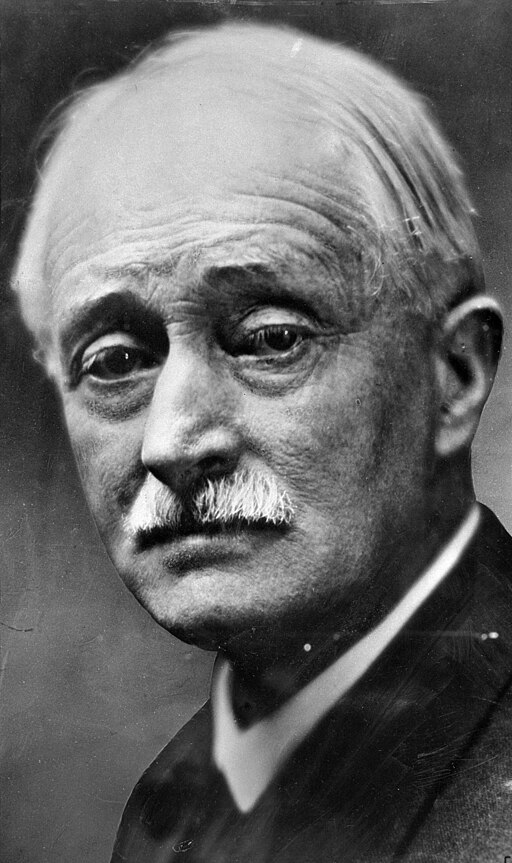
John Masefield - 1936
Los Angeles Times, CC BY 4.0, via Wikimedia Commons
Probably better known as the Poet
Laureate and for his poems than his novels, the fantasy story The Midnight Folk
and its sequel, The Box of Delights, which The Times claims are 'two of the
greatest children's books ever written', first published in 1927, are the work
of John Masefield.
John Edward Masefield was born in
Ledbury, Herefordshire, on the 1st June 1878.
When he was six, his mother died giving birth to his sister and he was
sent to live with his aunt.His father
died shortly after following a mental breakdown.
For three years to 1891, Masefield was
an unhappy boarder at Kings School, Warwick, leaving to board HMS Conway to
train for a life at sea, but also as his aunt intended, to break his addiction
to reading.However, he found that
during his three years on the Conway, he was able to spend much time reading,
writing and listening to stories about sea-lore, that his love of storytelling
grew.
His second ship, the Gilcruix, was
bound for Chile and sailing through extreme weather, seeing flying fish, porpoises
and birds, he was struck by the beauty of nature.Hospitalised from sunstroke, he eventually
returned to England as a steamship passenger.
In 1895 he went back to sea on a
windjammer destined for New York, but as a result of his lack of ambition to be
a sailor and his desire to write, he jumped ship when they docked.For several months he roamed the
countryside, living as a vagrant before returning to New York where he found
work as a barkeeper's assistant.In
December of that year, he read Duncan Campbell Scott's poem, The Piper of
Aril.Never before having cared much
for poetry, this impressed him so much that he was, so to speak, hooked!
When Masefield was 23, he met his
future wife, Constance de la Cherois Crommelin [1867-1960], 13 years his
senior.They married in London in June
1903.Despite the difference in their
ages, she was a good match for him, educated in English Literature and
classics, and a mathematics teacher.
Their daughter, Isabel Judith, known as Judith, was born in 1904
[d.1988] and their son, Lewis, in 1910, who was killed in action in Africa in
1942.
In 1902, Masefield was in charge of the
fine art section of the Arts and Industrial Exhibition in Wolverhampton, by
which time some of his poems were being published, including his first
collection, Sea-Water Ballads, in which the well-known Sea Fever appeared.This was followed in the next years by many
best-selling books of poems, novels and plays.
Although exempted from service in the
First World War, due to his age, he served briefly in France as a hospital
orderly.At around that time, he moved
his country retreat to Berkshire, the setting inspiring a number of poems and
sonnets.
During the war, Masefield undertook two
invited lecture tours in the United States increasing his ability as a public
speaker.At the end of his second tour,
both Yale and Harvard Universities conferred honorary doctorates of letters on
him and in 1921, Oxford University awarded him an honorary doctorate in
Literature.
During the 1920's he was an
accomplished and respected published writer, both of novels and poetry.The family were able to settle at Boar's
Hill, a rural setting not far from Oxford, where he enjoyed bee-keeping,
goat-herding and poultry-keeping.
On the death of Robert Bridges in 1930,
a new Poet Laureate was needed and on the recommendation of Prime Minister
Ramsay MacDonald, King George V appointed Masefield to the post, a position he
remained in until his death in 1967.
Following his appointment, the King awarded him the Order of Merit, and
many British
universities honorary degrees.He took
his appointment seriously and produced a great number of poems for royal
occasions.These were sent to The Times
for publication, his modesty shown by his inclusion of a self-addressed,
stamped envelope with each submission.
It was not until he was in his early
70's that he slowed down, mainly due to ill health.Following a long illness, Constance died in
1960 at the age of 93, which Masefield found distressing, having spent a long
year watching the woman he loved die.
In the autumn of 1966, he developed
gangrene in his ankle which spread and he died of the infection on the 12th May
1967.
In accordance with his wishes, he was
cremated, and his ashes placed in Poet's Corner in Westminster Abbey.However, sometime later the following verse
was found addressed to his 'Heirs, Administrators and Assigns.'
Let no religious
rite be done or read
In any place for me
when I am dead,
But burn my body
into ash, and scatter
The ash in secret
into running water,
Or on the windy
down, and let none see;
And then thank God
that there's an end of me.
Judie Weedon
32
CHILDHOOD LITERATURE
"Happy
spring!" said the elderly earth-worm, "And how was the winter with you?"
"Very nice, thank you," said Moomintroll, "Did you
sleep well, sir?"
"Fine," said the worm, "Remember me to your father and
mother."
"A
moomintroll is small and shy, round and smooth with a large snout that makes
them vaguely resemble a hippopotamus.
With a moominmama and a moominpapa, moomintrolls live in the forests of
Finland. They like sunshine and sleep
right through the winter. The snow
falls and falls where they live, until their houses look like great
snowballs. But when spring comes, up
they jump."
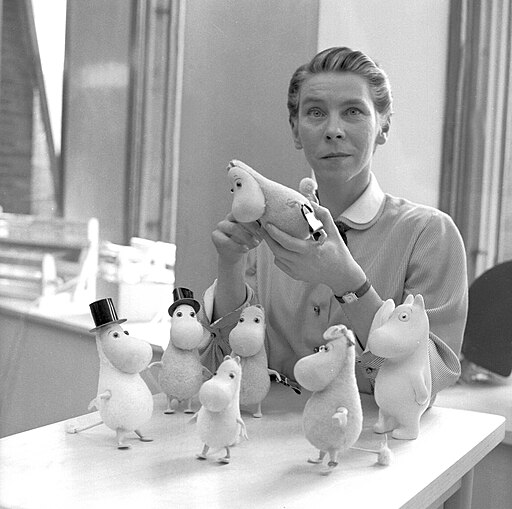
Artist and writer Tove Jansson in 1956
Reino Loppinen / Lehtikuva, Public domain, via Wikimedia Commons
In this
way began The Moomins and the Great Flood, written by Tove Jansson in 1945, the first of the many Moomin
tales that have captivated the young reader ever since.
Tove Marika Jansson was a
Swedish-speaking Finnish author, novelist, painter and comic strip artist. She was born in Helsinki on the 9th August
1914 and brought up by her artistic parents, Segne and Viktor. From1930 to 1938, she studied art in
Stockholm, Helsinki and Paris. Her
first solo art exhibition was in 1943, at the same time as she was writing
short stores and articles for publications, as well as creating the graphics
for book covers and other purposes. She
continued to work as an artist and writer for the rest of her life. She died, of cancer, on the 27th June 2001
in Helsinki and is buried with her parents and younger brother, Lars, at the
Hietaniemi Cemetery in Helsinki.
Jansson
had several male lovers, one of whom was her inspiration for the character
Snufkin. Many of her characters related
to her family and friends. However, as
she put it, she eventually 'went over to the spook side', a coded expression
for homosexuality.
In 1956
she met her lifelong partner Tuulikki Pietila.
Living in separate blocks, they visited each other privately via an attic
passageway. In the 1960's they built a
house on a remote island in the Gulf of Finland, where they spent summers together,
leaving Helsinki in April as the ice broke and returning in October. The island, which meant privacy, remoteness
and intimacy, has been highlighted in film and writings by them both.
Tuulikki
was an American born Finnish graphic artist and professor, born in Seattle on
the 18th February 1917. Influential in
Finnish graphic arts, she died in Helsinki in February 2009.
Besides
the Moomin stories, Jansson wrote and illustrated four original and popular
picture books.
Jansson's
Moomin stories have been translated in 35 languages and The Summer Book is one
of 10 novels that she has written for adults.
It is regarded as a modern classic in Scandinavia.
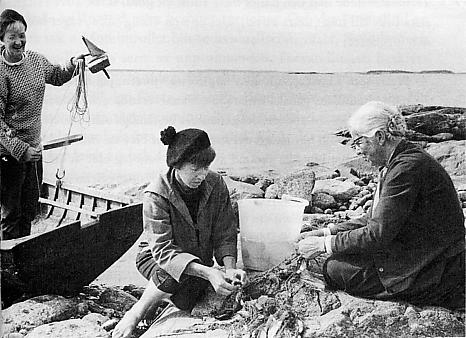
Tuulikki Pietila, Tove Jansson and Signe Hammarsten-Jansson - 1958
Unknown author, Public domain, via Wikimedia Commons
"One summer morning
at sunrise a long time ago
I met a little girl
with a book under her arm.
I asked her why she
was out so early and
she answered that
there were too many books and
far too little
time. And there she was absolutely
right."
Tove Jansson
Judie Weedon
34
CHILDHOOD LITERATURE
The Borrowers is a fantasy novel about
a family of tiny people who live secretly in the walls and floor of a house and
'borrow' from the full-size people to survive.
It is one of five written by Mary Norton, published in 1952 and
featuring in several adaptations for television and film.
Kathleen
Mary Pearson, known as Mary, was born on the 10th December 1903. Her father was a physician and she was
raised in a Georgian house in Leighton Buzzard. Now Leighton Middle School, the house is
thought to be the setting for her books.
Mary
was educated at convent schools after which, for a short time, she became an
actress for Lilian Baylis's Old Vic Company.
In 1927 she married Robert Charles
Norton and went with him to Portugal where his family and their business were
based. They had four children, two
boys and two girls. One of the boys has
become a printer and Microsoft executive.
On the outbreak of the Second World
War, Robert joined the Navy and in 1940, Mary worked for the War Office before
going with the four children to America.
It was here, whilst working for the British Purchasing Commission in New
York, that Mary began writing.
Her first book, The Magic Bed Knob or
How to Become a Witch in Ten Easy Lessons, was published by J.M. Dent in
1943. Returning to England at the end
of the War, the UK edition of the book was published in 1945. A sequel followed - Bonfires and Broomsticks
- in 1947, later, in 1957, to be combined in a single volume as Bed-Knob and
Broomstick. The stories were the basis
for the Disney film of 1971 as Bedknobs and
Broomsticks.
It was The Borrowers series, published
between 1952 and 1982, that established Mary Norton as a children's
writer. On the publication of the first
book, she was awarded the celebrated Carnegie
Medal from the Library Association; and
for the 70th Anniversary of the medal in 2007, it was named as one of the top
ten winning works. For so original and
imaginative writer with an irresistible
sense of humour, Mary was exceptionally modest and undemanding.
Following
the dissolvement of her marriage to Robert, in 1970 Mary married Lionel Bonsey [1912-1989], Commander RN, an author and playwright. For several years, and taking advantage of
the tax concessions to writers and artists, the couple moved to Ireland, before
returning to England and settling in a home in Devon in the village of
Hartland.
Lionel died in 1989 and Mary on the
29th August 1992. They are buried in
the churchyard of the parish church of St. Nectan. The inscription on their headstone is from
the well-known 1932 poem by Mary Elizabeth Frye.
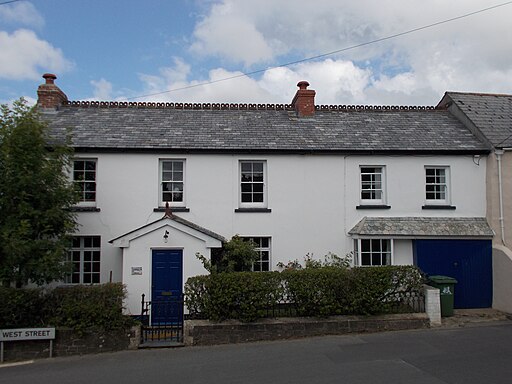
Borrowers Cottage, Hartland
John Q. Architext, CC BY-SA 3.0
via Wikimedia Commons

Lionel and Mary's grave at Hartland
In loving memory
LIONEL BONSEY
1912-1989
COMMANDER R.N
AUTHOR & PLAYWRIGHT
Do not stand at my grave and weep.
I am not there. I do not sleep.
I am a thousand winds that blow.
I am the diamond glints on snow.
I am the sunlight on ripened grain
I am the gentle autumn rain.
Do not stand at my grave and cry,
I am not there, I did not die.
Frye was an American poet and florist,
born in Ohio on the 13th November 1905, died on the 15th September 2004 in
Baltimore.
Judie Weedon
41
CHILDHOOD LITERATURE
"Ma sighed gently and said, "A whole year gone, Charles!" But Pa answered, cheerfully: "What's a year amount to? We have all the time there is."
This quote, almost relevant for today, comes from Little House on the Prairie, one of the eight Little House books by the American, Laura Ingalls Wilder, based on her childhood experiences in a settler and pioneer family.
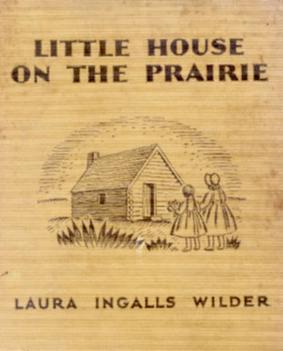
Little House on the Prairie - First edition cover
By Helen Sewell (illustrator) - Public Domain
via Wikimedia Commons
"Everything from the Little House was in the wagon except the beds and table and chairs. They did not need to take these, because Pa could always make new ones."
Laura Elizabeth Ingalls, the daughter of Charles and Caroline Ingalls, was born in Pepin, Wisconsin on the 7th February 1867. She was the second of five children: Mary Amelia [1865], Caroline Celeste [Carrie] [1870], Charles Frederick [1875], who died nine months later in 1876, and Grace Pearl [1877].
Over the next few years, the family made many moves, settling in Kansas, again in Wisconsin, Minnesota, Iowa and De Smet in South Dakota, where her parents and Mary remained for the rest of their lives.
Once settled there, Laura was able to attend school, had several part-time jobs and made friends, one of whom was a bachelor settler, Almanzo Wilder.
In 1882, Laura took up a teaching post, admitting later that she didn't enjoy teaching but felt a responsibility to help the family financially. Between 1883 and 1885, she taught, worked for the local dressmaker and attended high school, but did not graduate.
Laura's teaching and studies ended in 1885 when she married Almanzo Wilder, ten years her senior and having achieved a degree of prosperity, the couple were able to start their life in a new home north of De Smet. In 1886, their daughter Rose was born, followed three years later by a son who sadly died 12 days after birth and was never named. On his grave he is remembered as 'Baby Son of A.S. Wilder.
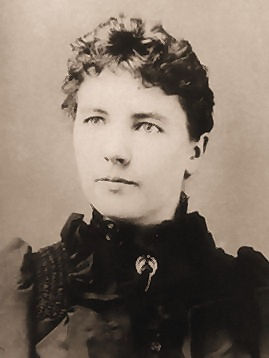
Laura Ingalls Wilder, circa 1885
Unknown photographer
Public domain, via Wikimedia Commons
In the early days of their marriage, life was far from easy. Following complications from a life-threatening case of diphtheria, Almanzo was partially paralysed but although eventually regaining nearly the full use of his legs, always needed a cane to walk. Then followed the death of their new-born son, a mysterious fire that destroyed their barn with its hay and grain, their home from a fire accidentally started by Rose, several years of drought, leaving them in debt and unable to earn a living from their 320 acres of prairie land. After these tragic events, they spent a year recovering with Almanzo's parents, followed by a brief and unsuccessful spell in Florida, hoping that the warm climate would help Almanzo's health, returning in 1892 to De Smet.
Two years later they moved to Missouri and into a ramshackle log cabin they named Rocky Ridge Farm. Over the next 20 years, with financial help again from Almanzo's parents, and sheer hard work, what began as about 40 acres of thickly wooded stone-covered hillside with a windowless log cabin, became a relatively prosperous poultry, dairy and fruit farm and a ten-room farmhouse. Laura was recognised locally as an authority on poultry farming and rural living, which led to her being invited to speak to groups in the area.
Her writing career began around 1911 when she became editor and columnist in the Missouri Ruralist, a position she held until the mid-1920's. While the Wilders were never wealthy until the Little House books began, her income from writing, the farm and Farm Loan Association, which she set up, provided them with a stable living.
During the 1920's and following her marriage, their daughter Rose Lane became involved, encouraging Laura to write, something she had successfully achieved herself. However, the Stock Market Crash of 1929 and the Great Depression wiped out the Wilders, although they still owned the 200-acre farm.
Pioneer Girl, Laura's first-person account of her childhood on the frontier was completed at about the same time, edited by Rose, but no publisher was interested. Refusing to become discouraged, Laura's 'I' became 'Laura' as well as writing specifically for children and including the whole family's experiences, success was achieved.
At the age of 65 in 1932, the first of Laura's eight Little House books was published, the final one published in 1943 when she was 76. By that time, she and Almanzo had sold off the majority of their land and livestock, continuing to live on the remaining 70 acres of Rocky Ridge. Here, Almanzo, or Manly as she called him, died in 1949 at the age of 92. For the next eight years she lived there alone, looked after by friends and neighbours. She also died there, aged 90, on the 10th February 1957. She was buried beside Almanzo at Mansfield Cemetery, and Rose, who died in 1968, is buried next to them.
Following her mother's death, Rose Wilder Lane edited her mother's diary, the resulting book On The Way Home: the Diary of a Trip from South Dakota to Mansfield Missouri in 1894, was published in 1962. Twelve years later, the long-running television series based on the stories, began, and the popularity of the books continues today.
Judie Weedon
28
And having shoes but half a pair;
Then fortune and then fame would fix
And gallop in a coach and six."
The
History of Little Goody Two-Shoes was published in 1765 and there have been few
children's books that have continued for so long, with numerous versions
published, even a pantomime based on the story, in both England and America,
but none latterly.
.jpg)
Cover of the 1888 edition of Goody Two-Shoes
High resolution scan at Archive.org
Public domain, via Wikimedia Commons
The story has been attributed to Oliver
Goldsmith, although this has been disputed and the author still remains
anonymous.
Goody
Two-Shoes is thought to be the first really successful children's book. It tells the tale of two orphans, Margery
Meanwell and her brother Tommy. Dressed
in rags and with only one shoe, Margery is given a pair by a charitable
gentleman. She is so happy that she
tells everyone she has two shoes!
Through
hard work she becomes a teacher, later marrying a wealthy landowner. At the time of her wedding, Tommy returns
from overseas having made his fortune and providing Margery with a dowry. When she is widowed, she uses her inherited
wealth to help the poor as she herself had been helped.
Although
there is obviously a moral aspect to the story, with lessons on hard work,
education and honesty, the book was in fact written to entertain, remaining
popular well into the 19th Century.
This
anonymous story was published by John Newbery, one of the first publishers to
produce books expressly written for children.

Patent medicines, sold by John Newbery
Advertisment in Good Two-Shoes
He was
born in Waltham St. Lawrence, near Reading, in 1713. Having been apprenticed to a publisher, he
set up a bookshop and publishing house in London in 1744. Two other notable publications are A Little
Pretty Pocket-Book and the first collection of nursery rhymes, Mother Goose's
Nursery Rhymes.
Newbery
was an eminent innovator. He produced
the first children's periodical - the Lilliputian Magazine [1751-52] - which
contained stories, verse, riddles, dances and songs.
One of
the most successful medications was Dr. Robert James's Fever Powder. The ingredients were kept secret but an
analysis in 1791 revealed the main constituents as antimony and calcium
phosphate. Newbery's friend Oliver
Goldsmith [possibly why he was thought to have written Goody Two-Shoes], swore
by it and when ill refused to be treated with anything else. Sadly, he died aged only 45 in 1774 from
kidney disease. The life and times of
Dr. Robert James is another story!
Newbery
married Jordon May Carnan in 1739. They
had 3 children, Mary [1740], John [1741-1752] and Francis [1743]. He died on the 22nd September 1767 and is
buried in his birthplace of Waltham St. Lawrence.
Strangely,
there is a connection between this book, a worldwide 'flu epidemic and
today! By 1919 the spread of Spanish
'Flu was resulting in alarming cases of death and to stop the cycle of the
disease spreading, the government in both Sydney and Melbourne closed all
places where people congregated, including schools, theatres and music
halls. This affected the show at Her
Majesty's in Melbourne, a production of Goody Two-Shoes, the pantomime!
In 1922,
in Newbery's honour, the Newbery Medal was created by the American Library
Association. It is awarded annually to
the most distinguished contributors to American Literature for Children.
Judie Weedon
27
CHILDHOOD LITERATURE
Wonk
grunted. He was lying very comfortably
on a grassy bank, and did not feel disposed to talk. "Conversation and Comfort" he reflected, "do
not go together."

Wonk by Muriel Levy
Illustrated by Joan Kiddell-Monroe
Scanned from Going to Sea
Published 1946
Published by Wills & Hepworth Ltd. of
Loughborough for Ladybird Books, the Adventures of Wonk is a series of six
titles - Going to Sea, Strawberries and Cream, Fireworks [1941], The Secret
[1945], The Circus and The Snowman [1945].
Each
of the books has two stories recounting the everyday adventures of Wonk, a
sleepy, loveable Koala character and his best friend, a young boy named Peter. Through all the stories, Peter and Wonk are
fairly care-free and left to their own devices much of the time, capturing the
innocence of childhood in the 1940's.
Written by Muriel Levy, 'Auntie Muriel' of Radio fame, they were all
illustrated by Joan Kiddell-Monroe.
Muriel Augusta Levy was born on the 2nd
August 1908 in London, the daughter of Polish-born Louis Levey and his British
wife, Amelia. By 1911, the family had
moved north to Liverpool where Muriel attended the prestigious Liverpool
College.
In the early days of BBC Radio, Muriel was
one of the voices heard on the Liverpool Station, which
began broadcasting in 1924, soon becoming a radio personality known to generations
of children as 'Auntie Muriel'. By the
late 1920's, she was organising Children's Hour and Woman's Hour, as well as
writing scripts for radio, eventually totalling over 3,000, and adapting
literary works such as The Forsyte Saga.
Taking an active interest in promoting
literacy, from the 1920's through her weekly column in the Liverpool Echo,
Auntie Muriel's Treasure Chest, she encouraged children to read and draw for
including in her articles. Sitting on
the Committee of the National Library for the Blind, she chose books for
translation into braille. She was also
Chairman of the Liverpool Child Welfare Fund.
Muriel married twice, firstly Rudolph
F. Taylor and then James Goodier, and had one daughter. She died on the 30th March, 1972, aged 68.
Joan Kiddell-Monroe, a British author
and illustrator of children's books, was born in Clacton-on-Sea on the 9th
August 1908. She studied at the Chelsea
School of Art and worked in advertising before becoming a freelance
artist. In the late 1930's she married
Webster Murray, a Canadian illustrator, travelling with him before the War in
Africa. Following his death in 1957,
she returned there with their son. Her
later years were spent in Majorca where she died in 1972.
Judie Weedon
39
CHILDHOOD LITERATURE
Ameliaranne Stiggins was sad. Though spring was in the air and the bluebells out and all the birds singing, Ameliaranne could think of nothing but - BOOTS! And even the twenty-five ringlets which bobbed about her neck looked sad and limp.
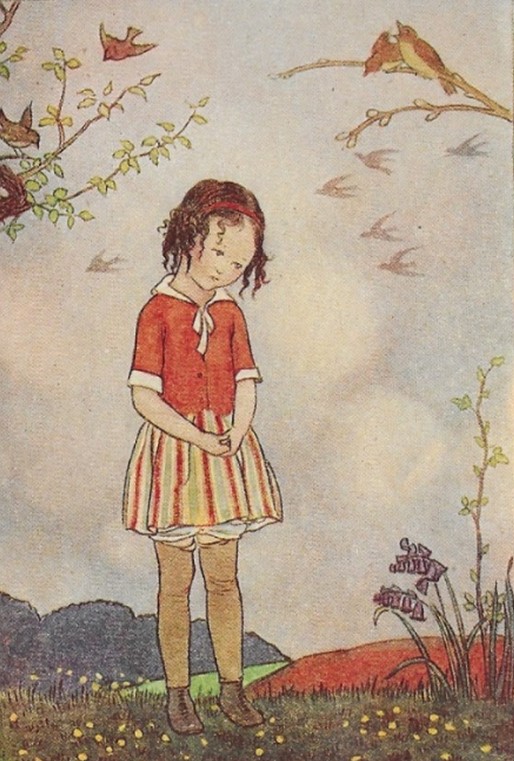
Ameliaranne by Constance Heward
Illustrated by Susan Beatrice Pearse
Scanned from Ameliaranne Keeps Shop
Published 1941
The Squire was giving a treat to the village children next week. A green and yellow bus was coming from town to take them to the bluebell woods, and after they had picked as many bluebells as they could carry they were to have tea in Farmer Brown's barn, and then they were going to look for eggs, and feed the calves, and play hide-and-seek in the farmyard.
When the invitation came for the six Stigginses, Mrs. Stiggins got out the family's boots. "Ameliaranne and Richard and Rosalind can go," she said, "but Jenny and Joey and Wee William must stop at home. Their boots are through and not worth mending, and there'll be no money to buy new ones this month, and trapesing about that farmyard would finish 'em out and out!" [From Ameliaranne Keeps Shop (1928)]
Ameliaranne Stiggins is the eldest daughter of a poor washerwoman. She has five brothers and sisters - Richard, Rosabel, Jenny, Joey and Wee William. The simple stories tell of new or difficult situations in which Amedliaranne finds herself and how she solves them with her imagination and ingenuity.
Published between 1920 and 1950 by George G. Harrap of London, the series of 20 books were unusually written by 8 different female authors. The original tale, written in 1920 and 7 others, the last in 1941, were written by Constance Heward [1884-1968]*. In spite of the diffeent authors the stories are surprisingly consistent, largely ahieved by the effective and charming illustrations by a single illustrator, Susan Beatrice Pearse.
Best known for her work on the Ameliarrane tales, Pearse was born in South London in 1878, and educated at King Edward's School Southwark. Also creating drawings for greetings cards, she was known to her friends as Trissy, and continued to use her maiden name professionally after she married Walter Webster in late 1919. She died in Fulham in 1980 at the age of 102.
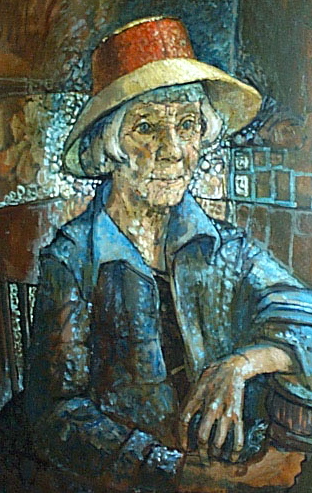
Susan Beatrice Pearse
Richard Attix, CC BY-SA 3.0
via Wikimedia Commons
* Sadly, no information can be found about Constance Heward, the originator of these books.
From Helen
Last time I was home I discovered this little book my mum had as a child. Attracted by the adorable illustrations, I picked it up and started reading. I was soon drawn in to the story of Ameliaranne and her siblings and devoured it cover to cover sat at the kitchen table.
After I finished, I was struck by several things. First the hero of this story is a girl. A young, poor, working class girl just 8 years old. She uses her wit and intelligence to not only identify the fraudster but to trick him and catch him out. She is clever and smart.
This little girl works hard to earn money so her younger siblings can have boots to wear so they can go on the picnic trip. She displays empathy, has clarity on what's right and what's wrong, is honest, strong and hard working. She is a girl, she tricks the adult man.
Ummm! What no Prince required? No pink, no Princess aspirations? No, it would seem not. And guess what? This story is nearly 100 years old.
Now that got me thinking about how far, or not, feminism and equality has really come and how the images and stories we are bombarded with influence our thinking . . . there's not a stereotype in sight with Ameliaranne, and I'm now off to recommend her to all my friends with kids!
Judie Weedon
33
CHILDHOOD LITERATURE
"Tomorrow I will begin", thought Katy, as she dropped asleep that night, and that's What Katy Did!
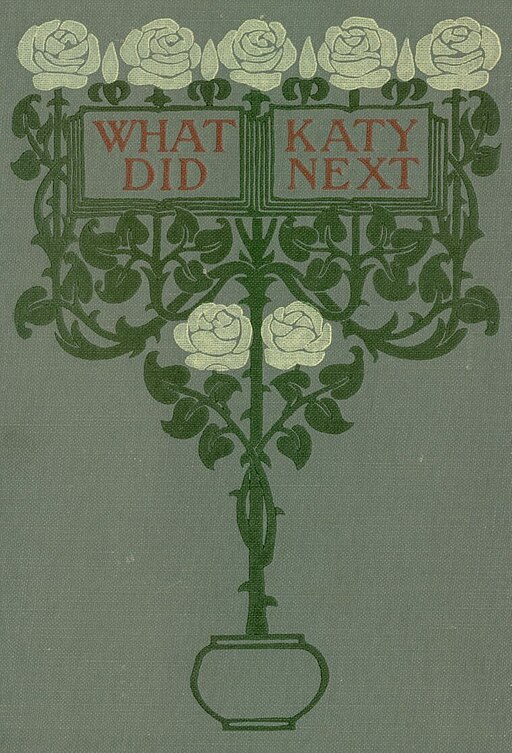
Cover from "What Katy Did Next"
Sarah Chauncey Woolsey
Published under Susan Coolidge
Public domain via Wikimedia Commons
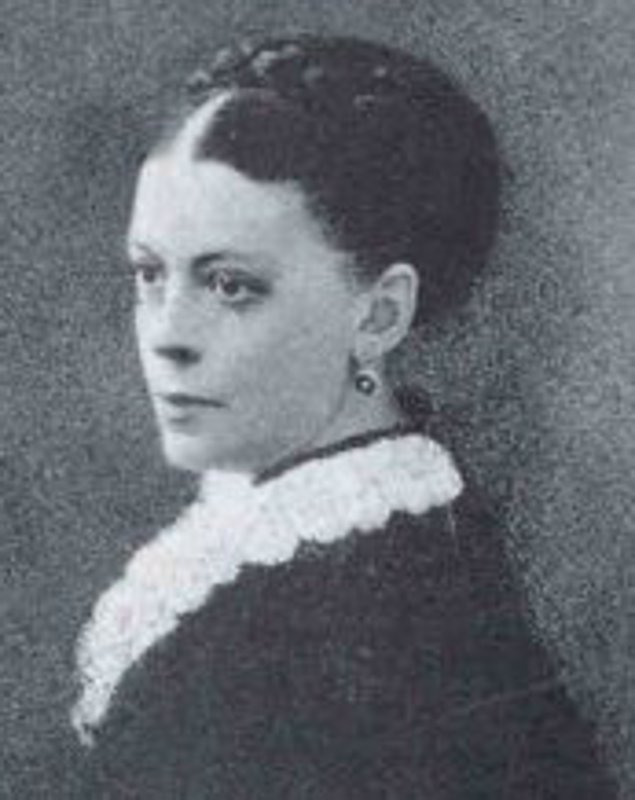
Sarah Chauncey Woolsey
[1835-1905]
By Unknown photographer
http://www.readseries.com/auth-bc/coolbio.html, Public Domain, via Wikimedia Commons
What Katy Did is an 1872 children's classic following the adventures of a twelve-year-old American girl, Katy Carr, a tall, untidy tomboy, always getting into scrapes, but wanting to be beautiful and loved. Invalided by a terrible accident, her four-year recovery gradually teaches her to be as good and kind as she had always wanted to be. Her adventures follow in What Katy Did at School [1873] and What Katy Did Next [1886]. The title is a play on the katydid, a family of insects, which explains the insects on the 1st edition book cover. The adventures of Katy's younger siblings appear in Clover [1888] and In The High Valley [1890].
The Katy books were the work of American author Sarah Chauncey Woolsey, who wrote under the pen name Susan Coolidge.
Sarah Woolsey was born in Cleveland, Ohio, on the 29th January 1835, the eldest of the five children of wealthy and influential New England parents, John and Jane Woolsey. The family later moved to New Haven, Connecticut in 1852.
During the American Civil War [1861-1865], Sarah worked as a nurse, after which she began to write, not only the Katy books but many other short stories, poems and other publications.
The fictional Carr family was modelled on her own, with Katy inspired by Sarah herself, and Katy's brothers and sisters on her own younger siblings: Jane Andrews Woolsey [25.10.1836] who married the Rev. Henry Yardley; Elizabeth Dwight Woolsey [24.4.1838-1910], who married Daniel Coit Gilman; Theodora Walton Woolsey [7.9.1840], and William Walton Woolsey [18.7.1842], who married Catherine Buckingham Convers, daughter of Charles Cleveland Convers.
Sarah Woolsey never married, always living in the family home until her death in Newport, Rhode Island, on the 9th April 1905.
Judie Weedon
38
CHILDHOOD LITERATURE
"We drove to Berrynarbor in the morning
of 5th, and we first passed the picturesque village of Hele with its pretty harbour; here papa
stopped to take a photography. We
walked up the hill and had a good view.
We passed Samsons Caves and reached Watermouth Castle. It was the residence of Mr. Bassett, who had
a large estate here. He was rather queer, they say he did not live at the Castle but at a
little house further on. His horse ran
away with him and broke his neck at the corner of a field further on.
"We returned inland, the road returning
beside a beautiful little trout stream.
this little valley is the prettiest place about here. Berrynarbor Church stands well on the top of
a hill. It is a quaint straggling old
village consisting chiefly of one steep street.
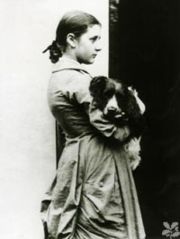
Beatrix Potter
Upload by
Adrian Michael
Public domain, via Wikimedia Commons.
"We stopped at the shop of the
churchwarden, who was the leading draper.
He was a tall thin man with a red nose.
We went up five or six steps through an old gateway into the churchyard,
in which stood some fine elms and a very old yew tree. The warden said it was eight hundred, it was
still full of vigour. In a railed space
were the graves of the Bassett family.
There were some beautiful lilies on the late Mr. Bassett's.
"The church is rather a large one with a
very fine old tower. Inside were two
fine old monuments to the Berry family, from which the place took its
name. The first dated 1642-6
represented the Lord and Lady kneeling dressed in ruffs, with the sons beneath
him and a daughter beneath her. The
second was larger, and represented a lady of the same house kneeling, in
ruff. The inscription was made on bad
stone and had flaked away.
"There was an old chapel with a Norman
arch. An old house, perhaps once the
vicarage, was said to be built at the time of Edward IV. Some carved stones in the wall bore the arms
of the Plantagenets, but they were taken to the Castle by Mr. Bassett.
"The village children came out of school
while papa was photographing the churchyard.
They came in at the front gate - the warden turned them out, whereupon
they immediately came in at the side one, but were again expelled. Mr. Poole was exceedingly angry."
So wrote Beatrix Potter in her diary of
1882.
Helen Beatrix Potter was born on the
14th March 1872 at 2 Bolton Gardens, West Brompton, London, her home until she
married in 1913.
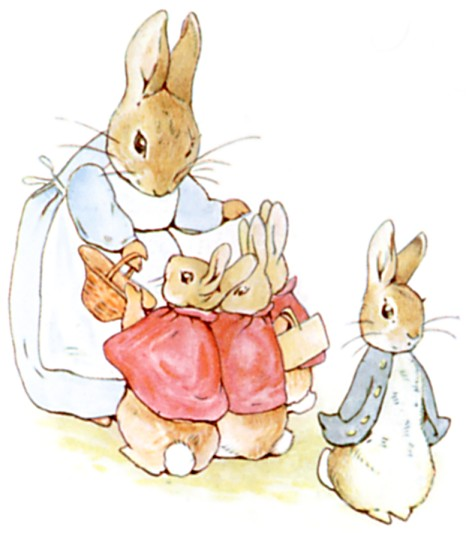
Peter Rabbit - from project Gutenberg
Beatrix Potter, Public domain, via Wikimedia Commons
Born into an upper-middle-class family
of the day, Beatrix was educated by three able governesses, the last Annie
Moore [nee Carter], just three years her senior, who also acted as a lady's
companion. They remained friends
throughout their lives and Annie's eight children, especially the eldest, Noel,
were the recipients of many of Beatrix's picture letters and it was Annie's
suggestion that these letters could make good books for children.
Beatrix and her younger brother,
Bertram, had few friends but numerous pets, which they both observed closely
and drew endlessly, including mice, rabbits and a hedgehog.
The family spent long summer holidays,
many in Scotland, but in 1882, whilst staying in the Lake District, she met who
was to be a lifetime friend, Hardwicke Rawnsley,
Vicar of Wray, later the founding secretary of the National Trust, whose
interest in country life and the countryside inspired the same in Beatrix. She was also interested in natural science
and botany and by the 1890's mycology became a passion, drawn to fungi because
of their colours and evanescence, delighting in painting them but also
resulting in her extensive and important research of them. Later, she gave her mycological and
scientific drawings to the Armitt Museum and Library
in Ambleside, where mycologist still refer to them to identify species. In 1967, the mycologist W.P.K. Findlay
included many of her detailed and accurate drawings in his book Wayside and
Woodland Fungi, fulfilling her wish to one day have her fungus drawings in
print.
In her teenage years, Beatrix regularly
visited the London art galleries, enjoying, as a critic, the exhibitions at the
Royal Academy. Sir John Everett Millais,
a friend of her father, recognised her talent of observation and although she
was aware of art and artistic trends, her drawing and prose style were uniquely
her own.
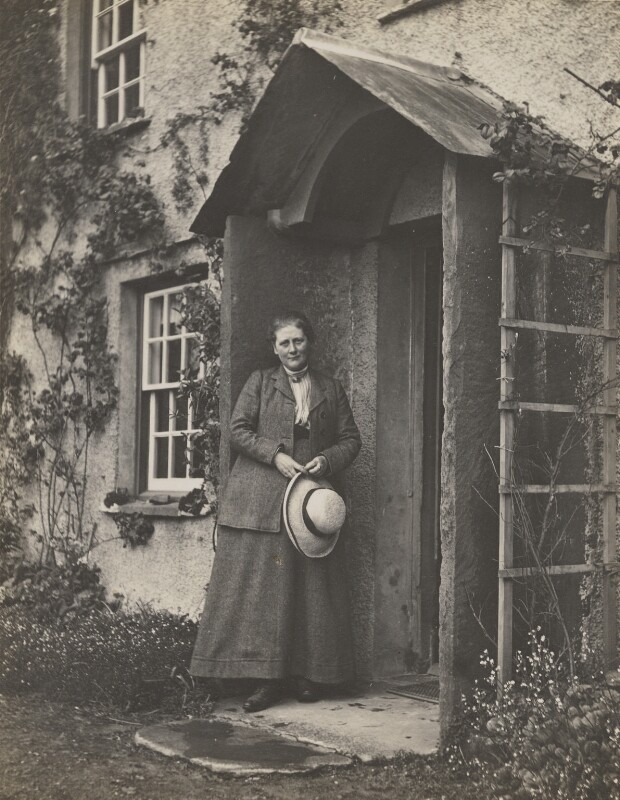
Beatrix Potter
by Charles G.Y. King
vintage snapshot print, May 1913
Purchased, 2013
NPG P1825
© National Portrait Gallery, London
Licenced under CC BY-NC-ND 3.0
In 1893 whilst on holiday, she ran out
of things to tell Noel in a letter, so she told him a story about 'four little
rabbits whose names were Flopsy, Mopsy,
Cottontail and Peter. It became one of
the most famous letters ever written and the start of her career as a
writer-artist-storyteller. She reused
the tale of the four rabbits in 1900, but unable to find a publisher, printed
it for family and friends at her own expense.
Rawnsley, having faith in the tale, took it to
the London publishing firms. Rejected
previously by Frederick Warne & Co., they reconsidered and accepted the 'bunny
book' as they called it. On 2nd October
1902, the Tale of Peter Rabbit, with coloured illustrations, was published and
was an immediate success. Other tales
quickly followed.
A canny business woman, in 1902 she made and
patented a Peter Rabbit doll, followed by painting books, board games,
wall-paper, figurines, baby blankets and china tea sets.
All were
licensed by Frederick Warne & Co., earning her an independent income and
vast profits for her publisher.
In 1905, she and Norman Warne became
unofficially engaged. Her parents
didn't approve, as Warne was 'in trade', but the engagement only lasted a
month, Warne dying of pernicious anaemia at the age of 37. That same year, Beatrix was able, with some
of her income, to buy Hill Top Farm in Near Sawrey,
near Windermere - she had always wanted to own the farm and live in 'that
charming village'.
Here she learnt the techniques of fell
farming, continuing to write and illustrate her books, she became a
prize-winning breeder of Hardwick sheep.
To protect her land and development and to purchase nearby Castle Farm,
Beatrix sought advice from W.H. Heelis & Son,
with William Heelis acting on her behalf.
By the summer of 1912, Heelis had proposed marriage and Beatrix accepted and they
were married on the 15th October 1913 at St. Mary Abbots in Kensington, then
living at Castle Cottage, the renovated farmhouse on Castle Farm.
At last her own woman, Beatrix settled
to the partnerships that shaped the rest of her life - her country solicitor
husband and his large family, her farms, the Sawrey
community, the rounds of country life and her illustrated stories. She and William had a happy marriage of
thirty years, continuing their farming and preservation efforts throughout the
hard days of two World Wars.
Beatrix died from pneumonia and heart
disease on the 22nd December, 1943 at Castle Cottage. She left nearly all her property to the
National Trust, including over 4,000 acres of land, sixteen farms, cottages and
herds of cattle and Herdwick sheep, the largest gift at that time to the
Trust. The central office of the Trust
in Swindon was named Heelis in 2005 in her
memory.
William Heelis
continued his stewardship of their properties and of her literary and artistic
works for the twenty months he survived her.
When he died in August 1945, he left the remainder also to the National
Trust, who in 1946 opened Hill Top Farm to the public, where her artwork was
displayed until 1985 when it was moved to William Heelis's
former law offices in Hawkshead, also owned by the Trust as the Beatrix Potter
Gallery.
The Tale of Peter Rabbit is owned by
Frederick Warne & Co., The Tailor of Gloucester by the Tate Gallery and The
Tale of the Flopsy Bunnies by the British Museum.
Her books
continue to sell and be read throughout the world in many languages with her
stories being retold in songs, films, ballet and animations and her life
depicted in a feature film and television film.
Judie Weedon
31
CHILDHOOD LITERATURE
"Congratulations flew fast and furious, for it had unquestionably been one of the most successful 'shows' ever undertaken by the squadron." This quote comes from the book Biggles Learns to Fly, just one of nearly 100 Biggles short stories and novels.
James Bigglesworth, nick-named Biggles, is a fictional pilot and adventurer and hero of the adventure stories written for young readers by Capt. W.E. Johns, who continued to write Biggles books until his death in 1968.
William Earl Johns was born in Bengeo, Hertford, on the 5th February 1893, the eldest son of Richard Eastman Johns, a fabric tailor, and Elizabeth, nee Earl. His early ambition was to be a soldier.
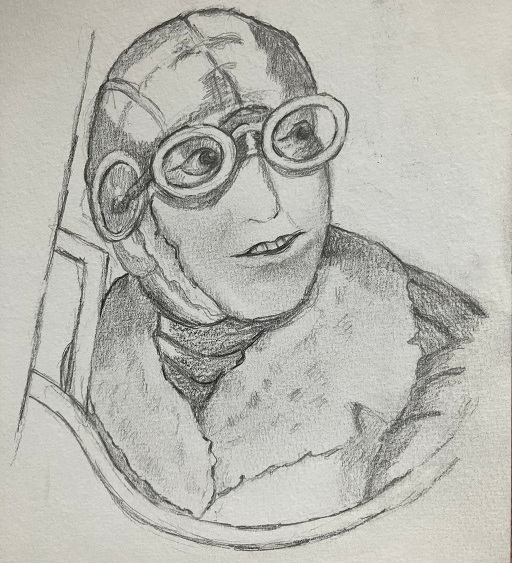
1954 Biggles Pioneer Air Fighter, thought to be after Stead
Illustration by: Judie Weedon
Not a natural scholar, from the age of 12, Johns attended Hertford Grammar School. In 1907 he began a 4-year apprenticeship to a county municipal surveyor and in 1912 was appointed a sanitary inspector in Swaffham, Norfolk. In October 1914, he married Maude Hunt, the daughter of the Rev. John Hunt, vicar of Little Dunham, Norfolk, and in March 1915, William Earl Carmichael Johns, known as Jack, their only son, was born.
Johns had a distinguished military career, beginning in 1913 when he enlisted in the Territorial Army as a Trooper in the King's Own Royal Regiment [Norfolk Yeomanry] and finishing in 1931 when he relinquished his commission from the Reserves.The Norfolk Yeomanry fought at Gallipoli until they were withdrawn to Egypt. In 1916 he was transferred to the Machine Gun Corps and while serving in Greece contracted malaria. On his release from hospital, he was commissioned into the Royal Flying Corps and posted back to England in 1917 for flight training, first at Coley Park, Reading, and then at Thetford in Norfolk, close to where Maude and Jack were living.
In April 1918, Johns was appointed flying instructor at Marske-by-the-Sea in Yorkshire. The aircraft at that time were most unreliable and he wrote off three planes in three days through engine failure - crashing into the sea, then the sand, and then through a fellow officer's back door. Later, he was caught in fog over the Tees, missed Hartlepool and narrowly escaped flying into a cliff. Shooting one's own propeller off with a forward-mounted machine-gun with malfunctioning synchronisation was quite a common accident, and it happened to Johns twice. During this time, his probationary commission was confirmed and he served as a flying instructor until August 1918 when he transferred to the Western Front.
He performed six weeks of active duty as a bomber pilot with No. 55 Squadron RAF, close to the average in the latter part of the war. This squadron was part of the Independent Air Force, a section of the Royal Air Force that had been formed for the purpose of bombing strategic targets deep inside Germany.
Flying Officer came in November 1920. He worked in central London as a recruiting officer and rejected T. E. Lawrence [of Arabia] as an RAF recruit for obviously giving a false name, but was later ordered to accept him.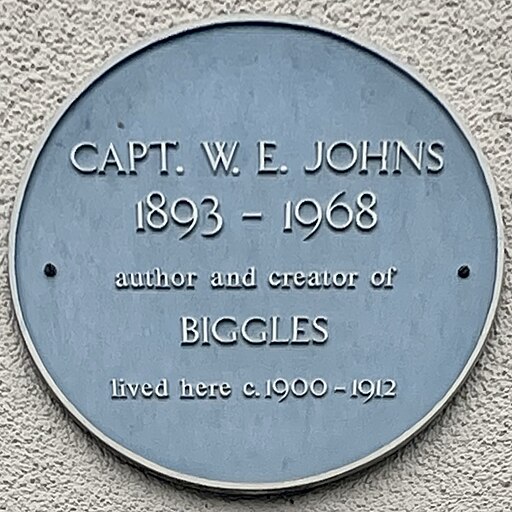
IrishCornelius, CC BY-SA 4.0
via Wikimedia Commons
On the 16th September 1918 he was piloting one of six De Havilland DH4s on their way to bomb Mannheim when his aircraft was hit by anti-aircraft fire and he was forced to drop out of formation. He jettisoned his single 250-pound [110 kg] bomb and turned for home, but was attacked by a number of Fokker D.VII fighters. During a lengthy, but one-sided battle, Johns' observer and rear-gunner, Second Lieutenant Alfred Edward Amey, was badly wounded and the aircraft shot down. Johns and Amey were taken prisoner by German troops. Johns had received a leg wound during the battle and was slightly injured in the crash, but Amey died of his injuries later that day. Johns remained a prisoner of war until after the Armistice of 11th November 1918.
After the war, Johns remained in the Royal Air Force, apparently with the substantive rank of Pilot Officer. His promotion to the rank of
By 1923, Johns had left his wife. His RAF commission had been extended a further four years and he had moved to Birmingham, again working as a recruitment officer. It was here he met Doris 'Dol' May Leigh [1900-1969], daughter of Alfred Broughton Leigh. They moved to Newcastle upon Tyne when Johns was posted there. He never divorced Maude Hunt, but Doris was known as Mrs Johns until her death. He continued to pay for his wife and son's upkeep and for her nursing care, she suffered from acute arthritis.
On 15 October 1927, he was transferred to the Reserves and four years later, in October 1931, he relinquished his commission.
Johns' writing career began in 1922 when he wrote under the name William Earle, but later adopted the now familiar name of Capt. W.E. Johns. His final RAF rank of flying officer, equivalent to an army lieutenant, captain is commonly used for the commander of a vessel or aircraft.
Johns' opposition to appeasement is apparent in some of his writing, and more advanced in his thinking, for the time, was the story of Biggles Air Commodore [1937] which alludes to Japanese preparations for conquest of British colonies in the Far East.
Apart from Biggles, his other multi-volume fiction series were the 6-book Steeley series [1936-1939], the 11-book series Worrals [1941-1950], the 10-book series Gimlet [1943-1954] and 10-book science fiction series of Tiger Clinton [1954-1963].
From 1953 until his death on the 21st June 1968, and his cremation, Johns lived at Park House, Hampton Court Road, Hampton Court in Middlesex.
Judie Weedon
32
CHILDHOOD LITERATURE

Readers of the Newsletter in April 2009 might remember
this illustration by Debbie Cook of the Robert Louis Stevenson poem Bed in
Summer from A Child's Garden of Verses
In winter I get up at night
And dress by yellow candle-light.
In summer, quite the other way,
I have to go to bed by day.
Robert Louis Stevenson is
probably better known for his books Treasure Island and Kidnapped.
Robert
Louis Balfour Stevenson was born in Edinburgh on the 13th November 1840, the
only son of Thomas Stevenson and his wife Margaret Balfour. Both his father and grandfather were
successful engineers, building many of the lighthouses around the Scottish
coast.
A sickly
child, his poor health made normal schooling difficult although he attended
Edinburgh Academy and at 17 went to Edinburgh University, where he was expected
to study engineering to follow the family profession, but he did not want to
become an engineer and eventually compromised with his father's agreement, to
study law.
From an
early age, Stevenson had shown a desire and aptitude to write and, in his
teens, to learn the writer's craft, he imitated a great variety of models in
prose and verse.
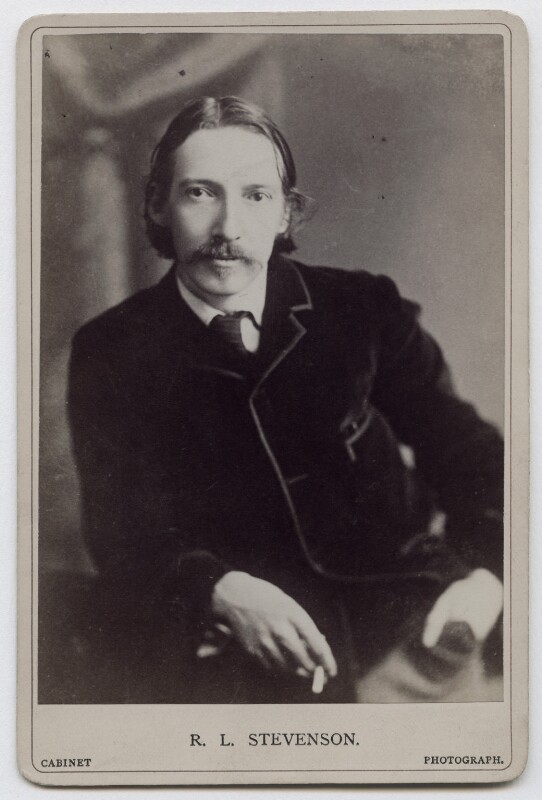
Robert Louis Stevenson
by James Notman
albumen cabinet card, 1890-1894
Given by Gabrielle Enthoven, 1925
NPG x39714
© National Portrait Gallery, London
Licenced under CC BY-NC-ND 3.0
In 1873,
visiting a cousin in Suffolk, he met Sidney Colvin, an English curator and
literary and art critic, who became a lifelong friend, and Fanny Sitwell, an
older woman of talent and charm, with whom be became infatuated. Fanny and Sidney later married. Later in the same year, Stevenson suffered
severe respiratory illness and was sent to the French Riviera, where Colvin
joined him.
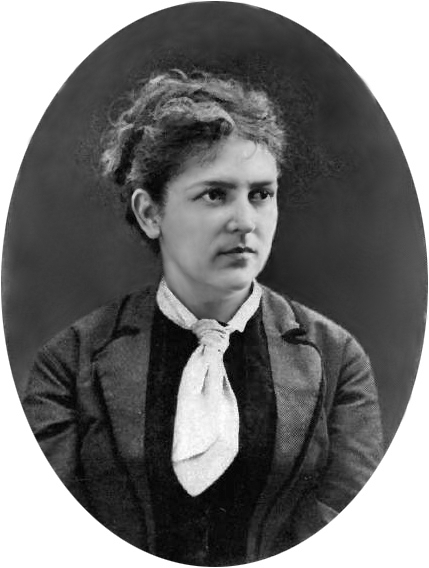
Fanny Osbourne
Nellie Van de Grift Sanchez
Public domain, via Wikimedia Commons
In July 1875, he was called to the
Scottish bar but never practised. The
following year, he met Fanny Osbourne,
an American, separated from her husband, and the two fell in love. His highly religious parents were horrified
at their son's involvement with a married woman, although they altered their
feeling when she returned to California in 1878. However, when Stevenson decided to join her
in August 1879, the bitterness returned even stronger.
After an
arduous journey in which Stevenson came near to death, he arrived in California
ill and penniless. He and Fanny, who
was then divorced, married in San Francisco in May 1880. At that time, his father relented and gave
his financial support, allowing the couple to return to Scotland, together with
Fanny's son, Lloyd. They were met at
Liverpool by his parents who were happy to see their son return home. Fanny was slowly able to patch up the
differences that had arisen over Stevenson's choice of career.
Over the
next seven years, to find a suitable climate to help Stevensons's
health - he was suffering from tuberculosis - they moved around a lot but
finally settled in Bournemouth, naming the house Skerryvore,
after the tallest lighthouse in Scotland, designed by his uncle.
Throughout
the years at Skerryvore, Stevenson was very ill, often being unable to leave
the house and when his father died in 1887, he was so ill that he was unable to
attend the funeral. His doctor advised
him to move to somewhere warmer, and with Fanny, Lloyd and his mother, they
sailed to America and returned to San Francisco.
In June
1888, Stevenson charted a yacht and set sail, and for nearly three years
travelled the eastern and central Pacific, the sea air and warm climate briefly
restoring his health. He decided to
remain in the Pacific and in 1890 bought a plot of land in Upolu, an island in
Samoa.
Here,
after much work and two aborted attempts to return to Scotland, he established
himself on his estate in the village of Vailima. He decided to take the native name of
Tusitala, Samoan for Teller of Tales.
He spent
the final years of his life living in Samoa, writing several works of fiction.
He died
suddenly on the 3rd December 1894 and was buried at the top of Mount Vaea above
his home on Samoa. Part of his own
short poem, Requiem, was written on his tomb:
Under the wide and starry sky
Dig the grave and let me lie . . .
Glad did I live and gladly die,
And I laid me down with a will.
This be the verse you 'grave for me:
Here he lies where he long'd to be;
Home is the sailor, home from the sea,
And the hunter home from the hill.'
Judie Weedon
31
CHILDHOOD LITERATURE
"Forth
to the wood did merry-men go
To
gather in the mistletoe."
from An Old Time Christmas, Sir Walter Scott [1771-1832]
"There is no time of the year at which we honour more old customs than at Christmas time. The whole season is full of them, and their beginnings go back down the centuries into the mists of time.
"We keep many of these old customs without knowing their meaning - but it adds much more to their interest if we know how they began, where and why. Why is plum-pudding called that when there are no plums? Why do we always hang up holly and mistletoe/ Why do we give presents, and have a Christmas tree? Who was Santa Claus?"
So writes Enid Blyton in the Foreword of one of her probably lesser known books - The Christmas Book - first published in 1944.
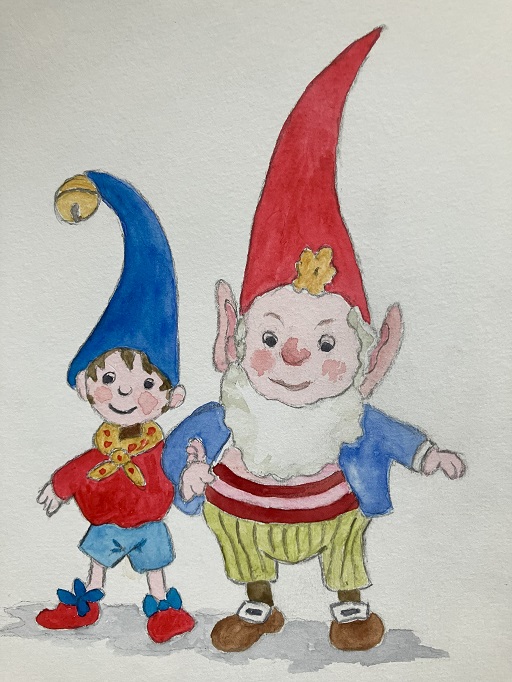
Noddy and Big Ears - After Harmsen van der Beek
Illustration by: Judie Weedon
Blyton's writings for children were prolific with over 600 million copies sold. Perhaps the Adventure Series - Jack, Lucy, Dinah, Philip and Kiki Philip's pet parrot, The Famous Five - Julian, Dick, George, Anne and Timmy the dog, The Secret Seven, the St. Clair's and Mallory Towers series, Mary Mouse and Sunny Stories are amongst the most popular, but Noddy must also be mentioned with Noddy Goes to Town, the first of 24 written between 1949 and 1963.
From 1907 to 1915 she attended St. Christopher's School in Beckenham, where she excelled in physical activities and writing, but not so in the academic subjects. After leaving, she moved to Woodbridge in Suffolk and in 1916 enrolled on a National Froebel Union Teacher Training course which she completed in December 1918 gaining a teaching certificate with distinctions in Zoology and Principles of Education, 1st Class in Botany, Geography, Practice & History of Education and Child Hygiene and 2nd Class in Literature and Elementary Mathematics.
In August 1924 she married Major Hugh Alexander Pollock DSO [1888-1971] who was involved with the publishing firm George Newnes, which became her regular publisher. In July 1931 and living in Bourne End, her daughter Gillian was born and following a miscarriage, her second daughter Imogen was born in October 1935.
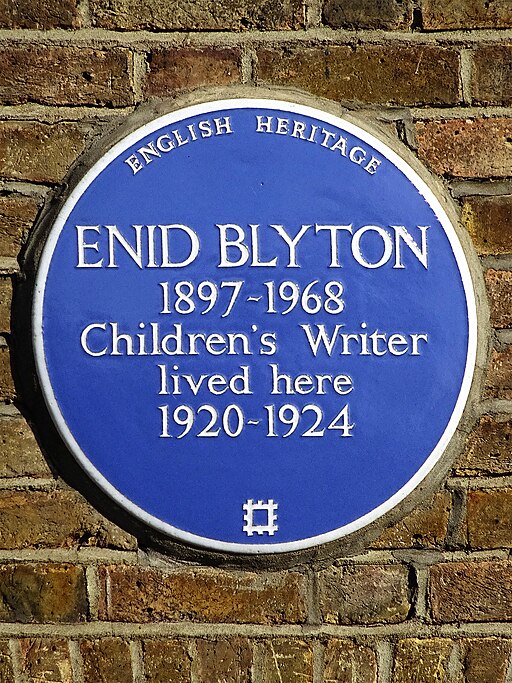
Blue plaque erected in 1997
by English Heritage
207 Hook Road, Chessington KT9 1EA
Spudgun67, CC BY-SA 4.0
via Wikimedia Commons
In 1938 the family moved to Green Hedges in Beaconsfield. By this time Pollock had withdrawn from public life and become an alcoholic, later having an affair with an aspiring writer 19 years his junior, Ida Crowe. With her marriage under strain, Enid herself began a series of affairs and in 1941 met Kenneth Fraser Darrell Waters, a London Surgeon. Fearing that her adultery would ruin her public image, she filed for divorce against Pollock and providing that he would admit infidelity, he would have access to their two girls. But, following the divorce she reneged and he was forbidden to contact them. Having married Crowe in 1943, he resumed his heavy drinking and was forced to petition for bankruptcy in 1950.
Enid and Darrell Waters married in October 1943 and she publicly embraced her new role as a happily married doctor's wife. After discovering that she was pregnant in the spring of 1943, she miscarried five months later following a fall from a ladder. This would have been Darrell's first child and the son for which both of them longed.
In 1957, Blyton's health began to deteriorate and by 1960 she was displaying signs of dementia. Her agent George Greenfield recalled that it was 'unthinkable for the most famous and successful of children's authors with her enormous energy and computer-like memory' to be losing her mind to what we now know as Alzheimer's in her mid-sixties. Unfortunately, this was not helped by the fact that her husband's health was bad - he was suffering from severe arthritis, deafness and increasingly becoming bad tempered. He died in September 1967.
Following his death, Enid's health declined rapidly and she moved into a nursing home three months before her death on the 28th November 1968. She was cremated at Golders Green Crematorium where her ashes remain.
Due to the controversial criticism of her writing which has been said to be elitist, sexist, racist and xenophobic and in particular her Noddy stories, her books have in some cases been banned from libraries and schools, but they have continued to be best-sellers.
Judie Weedon
20
CHILDHOOD LITERATURE
The simple bare necessities,
Forget about your worries and your strife,
I mean the bare necessities,
Old Mother Nature's recipes,
That brings the bare necessities of life."
This well-known song, written by Terry Gilykson, and sung by Baloo, the bear, and Mowgli, comes
from the 1967 Disney animated adaptation of the Jungle Book, written by Rudyard
Kipling and first published in 1894.
The human child, Mowgli, is raised by a wolf pack in the jungles of
India.As he learns the often-harsh
rules of the jungle under the tutelage of a bear, Baloo, and a panther named
Bagheera, he becomes accepted by the animals of the jungle as one of their own. Cover of the first edition of The Jungle Book [Joseph] Rudyard Kipling was an English
writer of novels, poems and short stories, mostly set in India and Burma,
notably his books for children - the Jungle Book, Just So Stories and Kim, the
story of a young Irish boy in India.He
was born in Bombay [Mumbai] on the 30th December 1865.His parents, John Kipling and Alice
MacDonald, who had met in 1863 spent time at Rudyard Lake in Staffordshire,
were so taken by its beauty that they named their first child after it. Kipling left India at the age of five
when he and his three-year old sister, Alice known as Trix,
were sent to Southsea, England, to live for 6 years with a couple who boarded
children of British Nationals living abroad.
Kipling recalled this time with revulsion, suffering from cruelty and
neglect, although Trix fared better.In the spring of 1877, their mother returned
from India and removed them. In January 1878, Kipling was enrolled
at The United Services College at Westward Ho!, a
school founded to prepare boys for the Army, which proved tough for him.Apparently, not having the academic ability
to obtain a scholarship to Oxford University and as his parents did not have
the finance to fund him, his father arranged for a job for him in Lahore.So, in September 1882, he returned to India. From 1883 to 1889 he worked for local
newspapers, the Civil and Military Gazette in Lahore and The Pioneer in
Allahabad.During this time his writing
continued at a frantic pace, but following a dispute
he was dismissed from The Pioneer and with the money he had accrued from his
writing, he decided to return to London. In March 1899 he left India, travelling
first to Rangoon, Singapore, Hong Kong and Japan before starting travels in
America where he met with Mark Twain and then crossing the Atlantic arriving in
Liverpool in October.Finding lodgings
in London, he made his literary debut there to great acclaim. In the next couple of years he published a novel, had a nervous breakdown and met
an American writer and publishing agent, Wolcott Balestier
with whom he collaborated and with whose sister Caroline, Carrie, he had an
intermittent romance.In 1891, on doctor's
advice, he took a sea voyage to South Africa, Australia and New Zealand and
again India, but cut the visit there short due to the sudden death from typhoid
of Balestier.
However, before returning to London he had proposed and been accepted by
Carrie via a telegram. Rudyard Kipling On the 18th January 1892 when Carrie
was 29 and Kipling 26, they married at All Souls Church, Langham Place, with
Henry James giving the bride away. Following their honeymoon in the United
States and Japan, where they learnt that their bank had failed, they returned
to America and Vermont where in a small cottage, they called Bliss Cottage,
their first child, Josephine, was born in 3 feet of snow on the 29th
December.It was at Bliss Cottage that
the idea of the Jungle Book first came to Kipling. They loved life in Vermont and in 1896
their second daughter, Elsie, was born.
Sadly in 1899, both Josephine and Kipling suffered from pneumonia from
which Josephine died when she was only six. The couple might well have lived out
their lives in America except that global politics and family discord saw them
returning to England and in 1896 they were in Torquay.In August 1897 they welcomed their only son
John. By this time Kipling was famous, his
writings prolific and they were financially secure.They moved from Torquay to Rottingdean in
East Sussex and in 1902, Kipling bough Bateman's, a house built in 1634,
located in Burwash, his home until his death in 1936. John was killed in action at the Battle
of Loos in September 1915, aged 18.He
had initially wanted to join the Royal Navy but his
enlistment was rejected twice due to poor eyesight.Kipling used his influence and John was
accepted into the Irish Guards.Kipling
was devastated by John's death and felt responsible.After the War, he became very active on the
War Graves Commission and by his perpetual endowment, The Last Post is sounded
every evening at the Menin Gate. Kipling's later work does not make
popular reading although some of his best writing was produced then.After the War he became increasingly
isolated and anti-democratic, even opposing Women's Suffrage.In 1895 he had refused the role of Poet
Laureate but in 1907 he did accept the Nobel Prize for Literature - the first
English author to be so honoured. Kipling died on the 18th January 1936
and was buried in Westminster Abbey. Bateman's
at Burwash, East Sussex, is now the property of the National Trust, open daily
all the year, 11.00 a.m. to 5.00 p.m. March to October, 11.00 a.m. to 4.00 p.m.
October to March.The house reflects
Kipling's association with India and the East and most of the rooms, including
his library, are much as he left them. Debbie Rigler-Cook Judie Weedon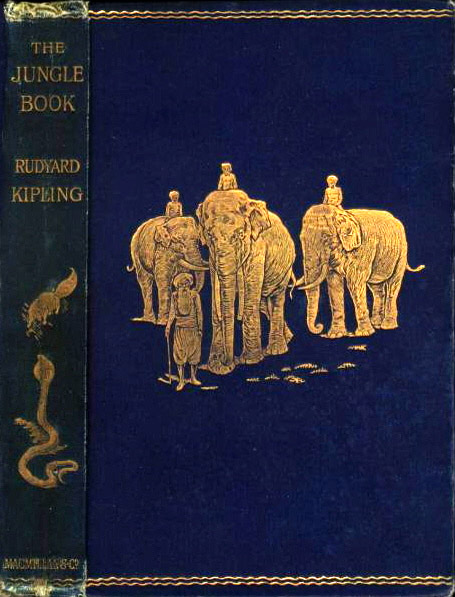
Illustrated by John Lockwood Kipling
Public domain, via Wikimedia Commons.
.jpg)
Elliott & Fry, Public domain
via Wikimedia Commons

20
CHILDHOOD LITERATURE
'She did not shut it
properly because she knew that it is very silly to shut oneself into a
wardrobe, even if it is not a magic one.'
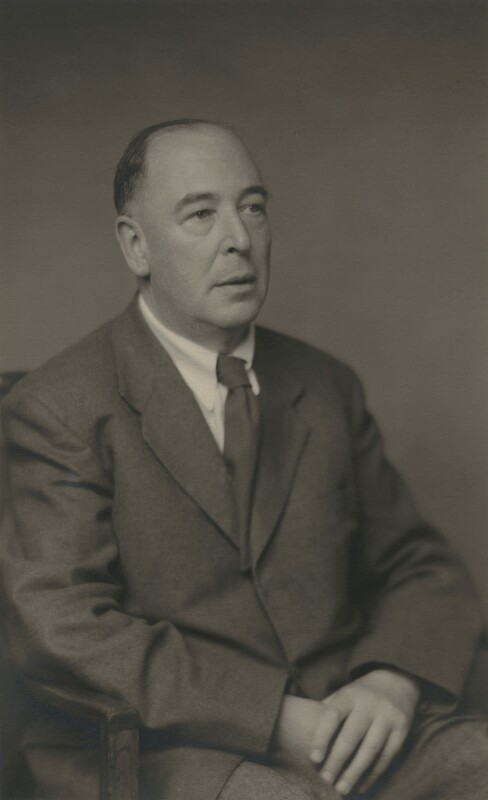
C.S. Lewis
by Walter Stoneman
bromide print, 1955
Commissioned, 1955
NPG x45075
© National Portrait Gallery, London
Licenced under CC BY-NC-ND 3.0
During World War II, four children are sent to the
country for safety. Lucy finds a
wardrobe that takes her to a magic world, Narnia. After coming home, she soon returns taking
her brothers Peter and Edmund and her sister Susan, where they meet the magical
lion Aslan.
So
begins The Lion, the Witch and the Wardrobe, a fantasy novel by C.S. Lewis, the
first of the seven novels in the Chronicles of Narnia.
Clive
Staples Lewis was born in Belfast in November 1898, the younger of the two sons
of Albert and Florence Lewis. When he
was four, his dog Jacksie was run over and he announced that his name was now
Jacksie, a name by which he was known by his family and friends for the rest of
his life.
As a
boy, Lewis, an avid reader, was fascinated by anthropomorphic animals,
especially those created by Beatrix Potter, and he wrote and illustrated his
own animal stories.
Until he
was nine, he was schooled by private tutors but following his mother's untimely
and impressionable death from cancer in 1908, he went first to board at Wynyard
School in Watford before returning briefly to Belfast and Campbell
Collage. Due to respiratory problems,
he was sent to Malvern, Worcestershire. where at the age of 15 he decided to
renounce his Christian faith and became an atheist. Later returning to Anglicanism at the age of
32, due to the influence of Tolkien and other friends.
In 1916,
following a further spell of private tutoring, Lewis was awarded a scholarship
at University College, Oxford. However,
within months of going up to Oxford, he was called up to the British Army and
shipped to France to fight in the First World War, arriving in the Somme Valley
on his 19th birthday, where he experienced trench warfare for the first time. In
August 1918, he was wounded, and two of his colleagues killed, by a British
shell falling short of its target.
During his recovery he suffered from severe depression and homesickness. On his demobilisation in December 1918, he
restarted his studies at Oxford, gaining firsts in Greek and Latin Literature,
Philosophy and Ancient History, and English.
In 1924 he became a philosophy tutor at University College and in 1925 elected
a Fellow and Tutor in English Literature at Magdalen College, a position he
held for 29 years until 1954.
Whilst
training in the Army, Lewis struck up a friendship with 'Paddy' Moore [1898-1918] and it is said that they
made a pact that if either died during the war, the survivor would take care of
both their families. When Paddy was
killed, Lewis kept his promise and lived with and cared for Paddy's mother,
Jane, until her death in 1951.
In 1930
Lewis moved to The Kilns, on the outskirts of Oxford, with his brother Warnie,
Jane Moore and her daughter Maureen, sharing the financial responsibilities.
After
the outbreak of the Second World War, they took in evacuees from London and other
cities and Lewis tried to re-join military service offering to instruct cadets,
but his offer was rejected. Later he
served in the local Home Guard. At the
same time be became President of the Oxford Socratic Club, a post he held from
1942 to 1954.
He was
nominated for a CBE by George VI in 1951, but declined to avoid association
with any political issues. However, he
did accept in 1954, the newly founded Chair of Medieval and Renaissance
Literature at Magdalene College, Cambridge, where he finished his career. He remained attached to Oxford, returning to
his home there at week-ends until his death in 1963.
In later
life, Lewis corresponded with Joy Davidson Gresham, an American writer who came
to England with her sons following her separation from her alcoholic and
abusive husband. To allow her to
continue living in the UK, she and Lewis entered a civil marriage in1956. Their relationship developed and when Joy
was diagnosed with terminal cancer, they sought a Christian marriage. Since she was divorced and this was not
straight forward in the Church of England at the time, a friend, the Rev. Peter Bide performed the ceremony
at her bedside in the Churchill Hospital in March 1957. After a short time in remission, her cancer
returned and she died in July 1960.
Lewis continued to raise Joy's two sons.
From
1961, Lewis's health began to decline.
Although there were times when his health improved, after suffering a
heart attack in July 1963, he died of renal failure on the 22nd November the
same year.
Lewis is
buried in the churchyard of Holy Trinity, Headington, Oxford. His brother, Warren [Warnie], died ten years
later and is buried in the same grave.
Media
cover of Lewis's death was almost completely overshadowed by the news of the
assassination of President J.F. Kennedy which occurred on the same day. In 2013, on the 50th anniversary of his
death, he was honoured with a memorial in Poets' Corner in Westminster
Abbey.
In
addition to his scholastic work, Lewis is best known for his many works of
fiction, his most popular being the Narnia novels which were written between
1949 and 1954, selling over 100 million copies and adapted numerous times for
radio, television, stage and cinema.
Judie Weedon
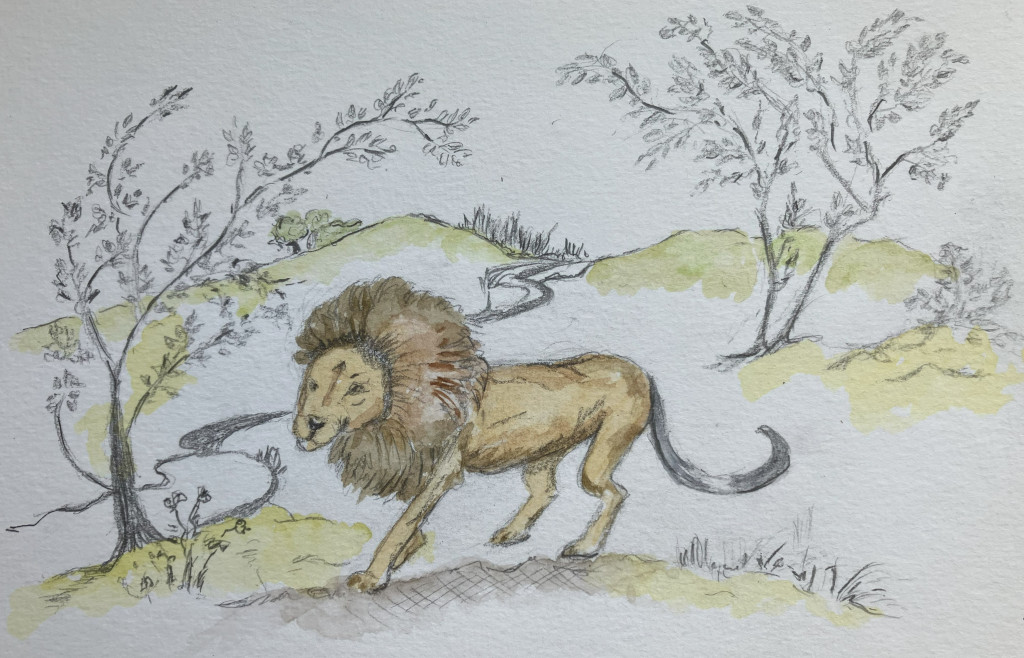
Aslan from The Wisdom of Narnia after Pauline Baynes
Illustration by: Judie Weedon
26
CHILDHOOD LITERATURE
"In fact
the fairies had turned him into a water-baby.
A
water-baby? You never heard of a
water-baby? Perhaps not. That is the very reason why this story was
written."
An
uneasy book when read as a child and even more so when read as an adult, Charles
Kingsley's 1862 novel, The Water Babies, is one of those perennial children's
classics that is not so perennial today!

Charles Kingsley
by Elliott & Fry
albumen carte-de-visite, circa 1866
Given by Phyllis Cunnington, 1962
NPG Ax18227
© National Portrait Gallery, London
Licenced under CC BY-NC-ND 3.0
The
story, initially written for his 4-year-old son, Grenville, Kingsley was
appalled by the plight of young sweeps in Victorian times, whose masters were
often brutal and condemned them to lives of misery often leading to early
deaths.
When a
young chimney sweep, Tom, is wrongfully blamed for a theft, he makes a run for
it, together with his dog Toby, ending up jumping into a fierce running river
where they encounter anthropomorphic underwater creatures. Before he can return and clear his name, Tom
has to rescue his new friends, the Water Babies, from their nemesis.
A live
action animated feature film directed by Lionel Jeffries loosely based on the
tale of the Water Babies was made in 1978 with a star-studded cast including
James Mason, Bernard Cribbins, Billie Whitelaw, Joan Greenwood, David
Tomlinson, Una Stubbs, David Jason, Lance Percival and Jon Pertwee.
Charles
Kingsley was born in Holne, Devon, in June 1819, the eldest son of the Reverend
Charles Kingsley and his wife Mary Lucas Kingsley. His childhood was spent in Clovelly, where
his father was curate and rector [1826-1836] and at Barnack in Northamptonshire. He was educated at Bristol and Helston
Grammar schools before studying at Kings College London and Magdalene College,
Cambridge, graduating from there in 1842.
He chose
to pursue a ministry career in the church and from 1844 was Rector of Eversley
in Hampshire. In 1859 he became
Chaplain to Queen Victoria and was appointed Regius Professor of Modern History
at Cambridge in 1860. In 1861 he became
private tutor to the Prince of Wales.
He
resigned his professorship at Cambridge in 1859 and from 1870 to 1873 was a
canon of Chester Cathedral when he founded the Chester Society for Natural
Science, Literature and Art and became the 19th President of the Birmingham and Midland Institute
in 1872. In 1873 he was made a cannon
of Westminster Abbey.
A social
reformer, historian and novelist, Kingsley married Frances Eliza Grenfell
[1814-1891] in 1844. They had two sons
and two daughters.
Kingsley's
1855 historical novel Westward Ho!, the seafaring adventures of Amyas Leigh,
led to the founding of the village of the same name near Bideford, the only
place name in England with an exclamation mark!
Kingsley
died in 1875 at his home in Eversley and is buried in the churchyard there.
In 2014,
his bust was taken from St. George's Chapel, Windsor and relocated in Poets'
Corner in Westminster Abbey and his statue stands on the Quay in Bideford.
His
poem, Easter Week, was included in the 2019 Easter Service at St. George's
Chapel, attended by the Queen and other members of the Royal Family.
Mabel Lucie
Attwell - born in Mile End London, in June 1879, was a British
illustrator and comic artist.
She illustrated children's classics such as Mother Goose (1910), Alice in Wonderland (1911), Hans Andersen's Fairy Tales (1914), The Water Babies by Charles Kingsley (1915), and an edition of J. M. Barrie's Peter Pan and Wendy abridged and written by May Byron (1921).
Studying
at Heatherleys and St. Martin's School of Art, she was known for her cute,
nostalgic drawings of children, often based on her daughter Marjorie [Peggy]
from her marriage to painter and illustrator Harold Earnshaw with whom she also
had two sons.
She died at her home in
Fowey, Cornwall, in 1964. Her drawings
and poems feature on many postcards, advertisements, posters, books and
figurines, are still popular and loved today.
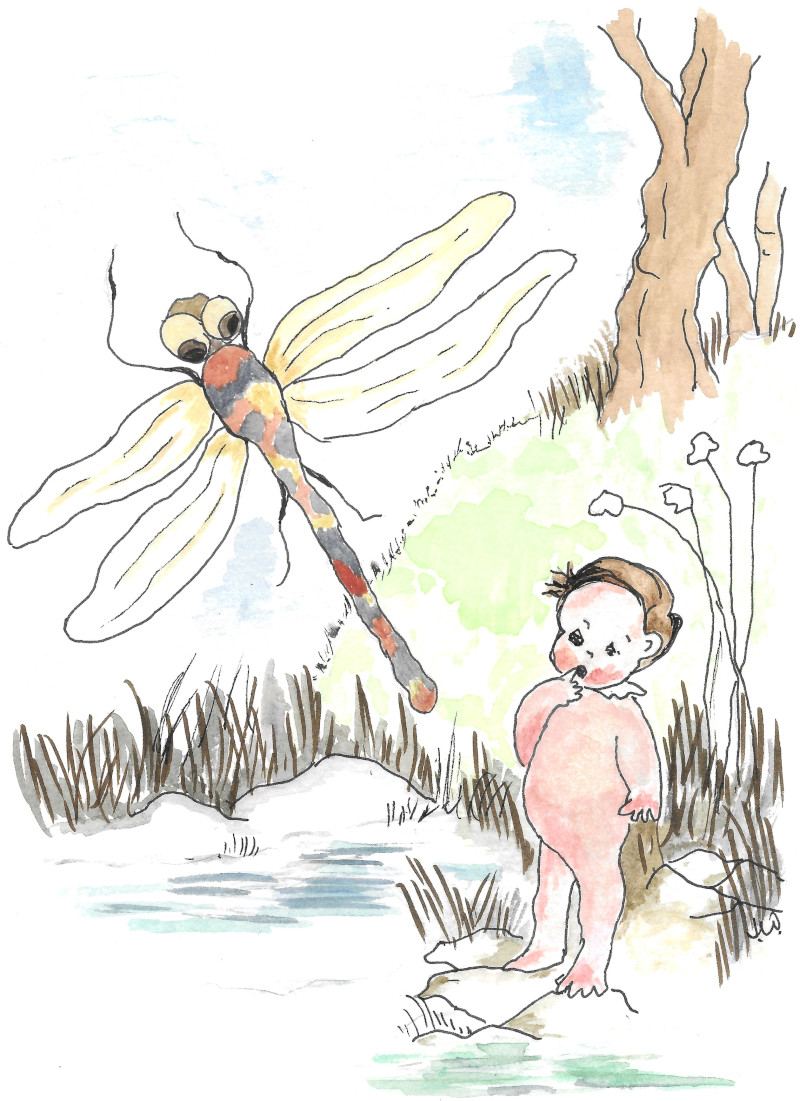
The Water Babies - After Mabel Lucie Atwell
Illustration by: Judie Weedon
Easter Week
See
the land, her Easter keeping,
Rises as her Maker
rose.
Seeds, so long in darkness
sleeping,
Burst at last from
winter snows.
Earth with heaven above rejoices;
Fields and gardens
hail the spring;
Shaughs and woodlands ring with
voices,
While the wild birds
build and sing.
You, to whom your Maker granted
Powers to those
sweet birds unknown,
Use the craft by God implanted;
Use the reason not
your own.
Here, while heaven and earth
rejoices,
Each his Easter
tribute bring -
Work of fingers, chant of voices,
Like the birds who
build and sing.
Charles Kingsley
.jpg)
Kingsley's statue on the Quay at Bideford
Taken by Mark New on 4th March 2006
CC BY-SA 3.0, via Wikimedia Commons
Judie Weedon
26
CHILDHOOD LITERATURE
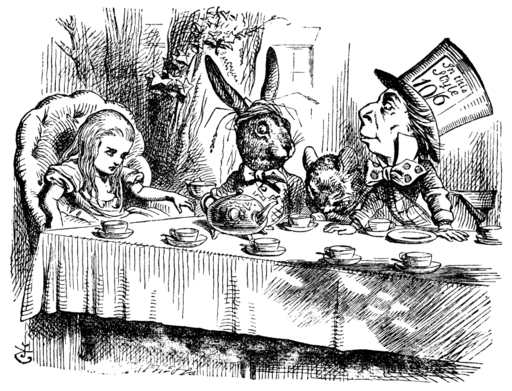
"Alice in Wonderland" illustration
by John Tenniel, Public domain, via Wikimedia Commons
"Oh, you can't help that," said the Cat, "we're all mad here. I'm mad, you're mad."
"How do you know I'm mad?" said Alice.
"You must be," said the Cat, "or you wouldn't have come here."
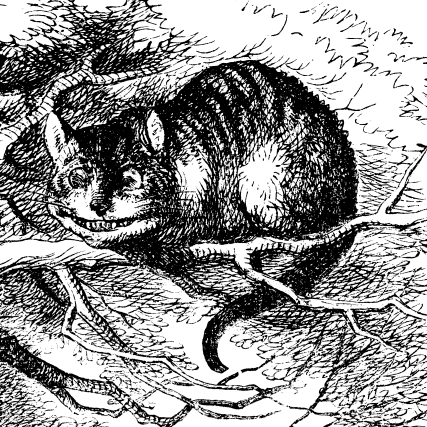
Cheshire Cat - by John Tenniel
Public domain, via Wikimedia Commons
In July 1862,
the author Lewis Carroll and the Rev. Robinson Duckworth rowed up the Isis from
Oxford with the three young daughters of the Vice-Chancellor of Oxford
University and Dean of Christ Church, Henry Liddell - Lorina [13], Alice [10] and Edith [8]. During the trip he told the girls a story
about a bored little girl named Alice who went looking for adventures. Captivated by the story, Alice asked him to
write it down for her. Alice's
Adventures in Wonderland came into being and was published three years later in
1865, with illustrations by John Tenniel.

Lewis Carroll
by Hills & Saunders
albumen print, 1860s
Given by Graham Ovenden, before 1977
NPG x5181
© National Portrait Gallery, London
Licenced under CC BY-NC-ND 3.0
Alice in
Wonderland, as it is known, was followed in 1871 by Through the Looking Glass
and what Alice found There. The tales
of Alice have appeared on stage and screen many times, two of which are the
American musical fantasy of Walt Disney in 1951, and the 2010 film directed by Tim Burton with an all-star cast including Johnny Depp as the
Mad Hatter, Mia Wasikowska as Alice, Anne Hathaway and Helena Bonham Carter as
the White and Red Queens, the late Alan Rickman as the Caterpillar, Michael
Sheen the White Rabbit, Barbara Windsor the sleepy Dormouse and Stephen Fry
grinning as the Cheshire Cat.
The tale takes
Alice into a fantasy world populated by humans and strange anthropomorphic
creatures, The story and its lasting
poplularity, with adults and children, is considered to be one of the best
examples of literary nonsense, the characters and imagery influential in both
popular culture and lieterature, especially in the fantasy genre.
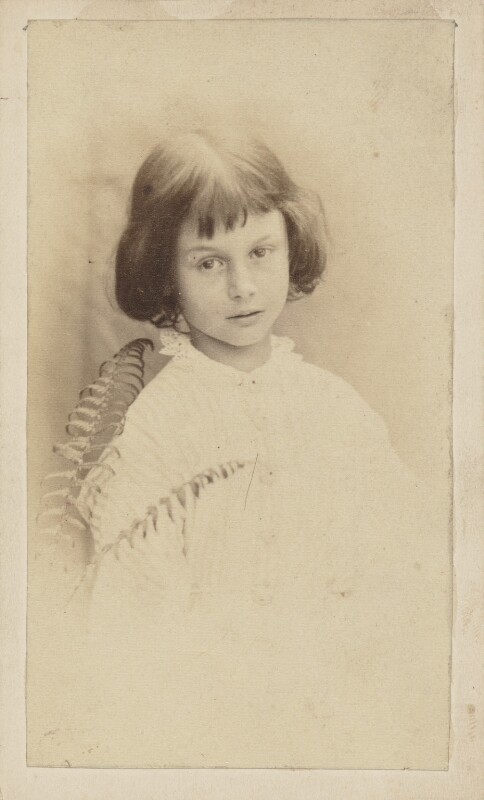
Alice Liddell
by Lewis Carroll
albumen print, July 1860
Purchased jointly with the National Science and Media Museum, Bradford, with help from the Art Fund and the National Heritage Memorial Fund, 2002
NPG P991(8)
© National Portrait Gallery, London
Licenced under CC BY-NC-ND 3.0
Charles Lutwidge Dodgson, known by his
pseudonym as Lewis Carroll, was born in the parsonage at Daresbury, Cheshire,
on the 27th January, 1832, the eldest boy of 11 children, a high church
Anglican family. His father, Charles
Dodgson, a gifted mathematician, took holy orders but became a country parson, marrying
his cousin Frances Jane Lutwidge.
The young Charles, who suffered from a
stammer, a condition shared by most of his siblings and one he found
debilitating all his life although he found it easier communicating with
children, was also a gifted mathematician.
He was initially educated at home, going to Richmond School in Yorkshire
when he was 12 and then on to Rugby School, where he was very unhappy. Being tall and slender, with a weak chest
caused by a severe childhood attack of whooping cough and a stammer, he was
possibly bullied.
He went on to Christ Church, Oxford,
and in 1852 was awarded the equivalent of a scholarship, took up residency
there and in 1854 awarded First
Class Honours in the Final Honours School of Mathematics. He was appointed a Lecturer in Mathematics.
Despite his growing wealth and fame,
little changed during the last twenty years of his life. He continued to teach at Christ Church until
1881 and remained in residence there until his death.
His social circle amongst others
included John Ruskin, Dante Gabriel Rossetti, William Holman Hunt and
Millais. Apart from his literary
success, Dodgson was an accomplished photographer with notable portraits of
Ellen Terry and Alfred Lord Tennyson.
He also photographed children, finding himself vocally fluent when
speaking to children
and entertaining them, enjoying their company and creating stories for
them. Despite conjecture, there is
little evidence of there being anything improper in his behaviour toward them.
Lacking in good health throughout his
life, suffering from migraine, epilepsy and micropsia [optical distortion] just
before his 66th birthday he contracted 'flu which turned to pneumonia, dying at
his sister's home in Guildford on the 14th January 1898. His funeral was held at the nearby church
of St. Mary and he is buried in Guildford at the Mount Cemetery.
By the time of his death, Alice and her
adventures had become one of the most popular children's books in England and
by 1932, one of the most popular in the world.
Judie Weedon
26
CHILDHOOD LITERATURE
The
Squirrel, the Hare and the Little Grey Rabbit was the first tale of these three
delightful furry friends and their adventures - the boastful hare, the vain and
scatty squirrel and everyone's friend, little grey rabbit. These and other characters - Moldy Warp, Fuzzypeg, Wise Owl, Water
Rat and more - are in some 39 books, charmingly illustrated by Margaret
Tempest, the imaginings of Alison Uttley. For many of us born in the 20th century,
these books became the bedtime stories of choice.
Born Alice Jane Taylor in December 1884
in Cromford, Derbyshire, Alison Uttley was educated
at the Lea School in Holloway and the Lady Manners School in Bakewell. It was here that she developed a love of
Science, leading to gaining a scholarship to Manchester University to read
Physics. In 1906, she became only the
second woman honours graduate of the University. She then trained as a teacher at Hughes Hall, Cambridge
before taking up a post in 1908 as a Physics teacher at Fulham Secondary School
for Girls in West London.
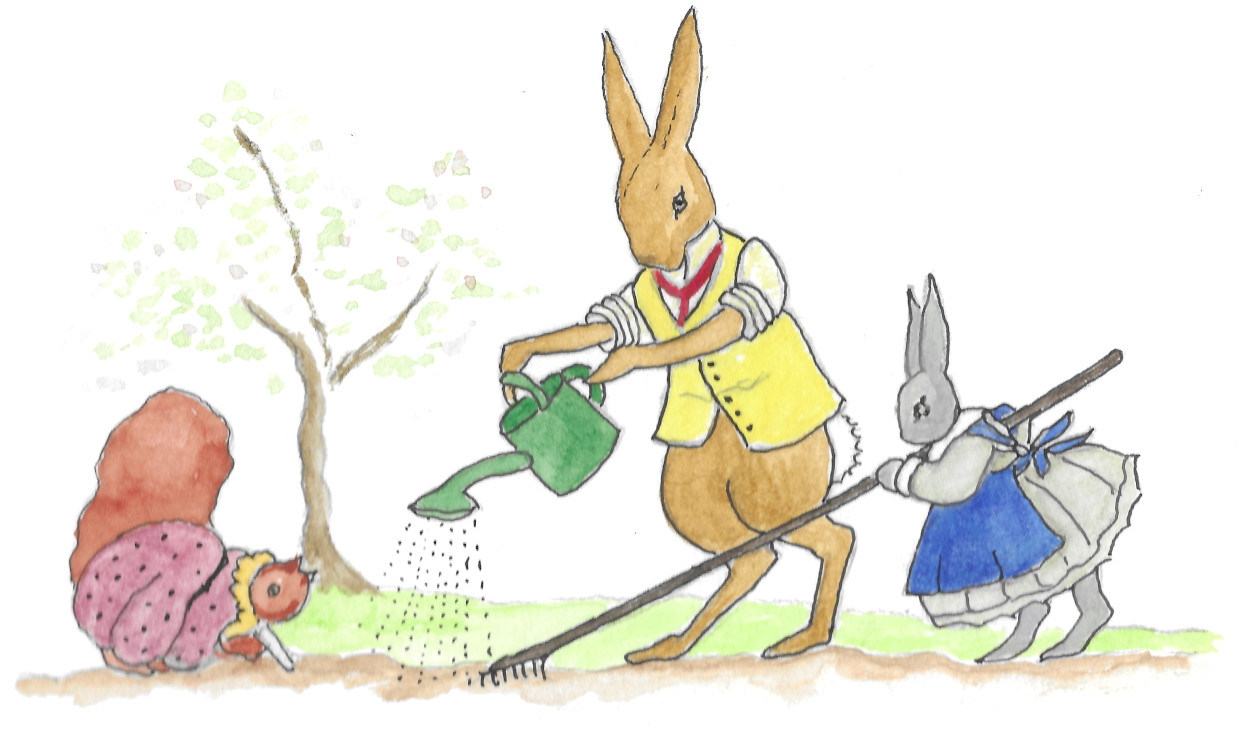
Little Grey Rabbit - after Margaret Tempest
Illustration by: Judie Weedon
In 1911 she married James Arthur Uttley and their only child on whom she doted, John Corin Taylor, was born in 1914. During the period 1924 to 1938, the family
lived in Bowdon, Cheshire, but sadly in 1930, and prone to depression, James
drowned himself in the River Mersey.
Some time
later, in 1938, Alison moved south to Beaconsfield where she became the
neighbour of Enid Blyton. Probably
jealous of Blyton's success, she came to dislike her, describing her as
boastful and vulgar. She also quarrelled
bitterly with her illustrator, Margaret Tempest.
The first Grey Rabbit, her first book
to be published, came out in 1929; other animal tales including the
Little Red Fox and Sam Pig followed.
Later, she wrote for older children and adults, focusing on rural
topics, notably in The Country Child [1931], a fictionalised account of her
childhood experiences on the family farm Castletop,
near Cromford.
In 1970 the University of Manchester
awarded her an honorary degree of Doctor of Letters in recognition of her
literary work.
She died at High Wycombe on the 7th
Mary 1976, aged 91.
From her diaries, published in 2009, it
is obvious that she was extraordinarily gifted but also very complicated. She was eventually estranged from Margaret
Tempest, over the copyright to her beautiful pictures and over which of them
had really created the characters. She
was bitterly resentful of comparisons with Beatrix Potter and scornfully
dismissive of Enid Blyton, whose work she despised. She took the work of literary creation very
seriously and relished her success, but was easily hurt by criticism and craved
affirmation from the public.
Extraordinarily gifted, she was also said to be singularly controlling
and dominating. Sadly, her son John,
whom she truly loved, killed himself two years after her death, by driving his
car off a cliff.
Margaret Tempest, author and
illustrator, was born in Ipswich, Suffolk, where she spent most of her
life. From 1914 she attended the
Westminster School of Art, co-founding
The Chelsea Illustrators Club, through which students exhibited and sold their
work.
In spite of not getting on personally
with Alison Uttley, from 1929 to 1960, she
illustrated the Little Grey Rabbit books, as well as other children's books,
including writing and illustrating her own, of the 'dressed animal' type.
Judie Weedon
22
"What's your name?" asked the little boy.
"Wendy Moira Angela Darling. What's yours?"
"Peter Pan."
"Where do you live?"
"Second turning to the right and straight on till morning."
"Sir J.M. Barrie's delightful
creation, Peter Pan, has by this time taken a secure place in the hearts of
children of all ages and there are few nurseries in the land in which Peter,
Wendy, Tinker Ball, Captain Hook and his Pirates, "the Mermaids and Redskins, and
the exciting world in which they live, are not as familiar as the most time-honoured lore of
fairyland." Daniel O'Connor, 1916.
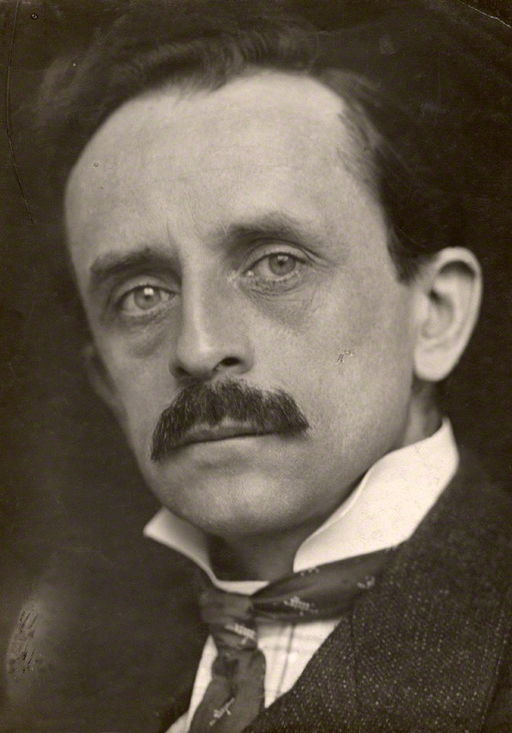
J. M. Barrie in 1902
George Charles Beresford, Public domain, via Wikimedia Commons
Peter Pan was written as a play and in
creating Peter, Barrie also created Wendy.
The Christian name had not existed before. He also created the 'Wendy House', today's
word for a child's play house. The play
was first performed in 1904 with Nina Boucicault as the first Peter and Hilda
Trevelyan as the first Wendy, continued annually except in 1939 and 1940 when
it was suspended during the early years of World War II.
In the London play, the part of Peter
has traditionally been played by a woman, including major stars of their era -
Dame Anna Neagle, Phyllis
Calvert, Margaret and Julia Lockwood, Sylvia Sim, Millicent Martin, Wendy
Craigh, Hayley Mills, Lulu, Maggie Smith, Anita Harris and others. Captain Hook has had his share of
celebrities including Gerald Du Maurier, Charles Laughton, Alastair Sim, John
Gregson, Donald Sinden, Ron Moody, Bill Travers, Erick Porter and Dave Allen.
The play has more recently appeared as
Pantomime, with spectacular effects and today's top entertainers queuing up to
appear as the boy who wouldn't grow up and the dastardly
Captain Hook - he's behind you! - has been played by Russ Abbot, Patrick Mower, Paul Nicholas,
Henry Winkler, Nigel Havers, Alvin Stardust and Leslie Grantham, alongside
Bonnie Langford, Michaela Strachan and with Joe Pasquale as the pirate
Smee. Breaking with tradition, some
Peter's are now male.
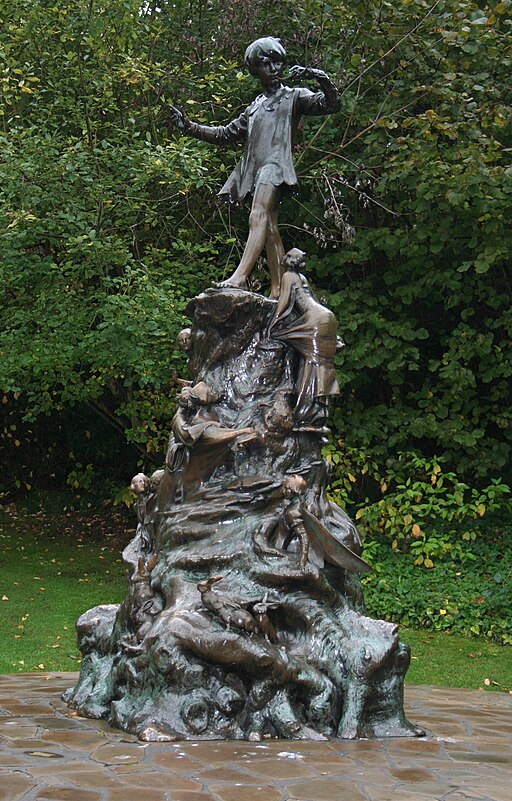
Monument to Peter Pan, Kensington Gardens, London
Peter Clarke, CC BY-SA 3.0, via Wikimedia Commons
Sir J[ames] M[atthew]
Barrie, 1st Baronet, OM, was born in Kirriemuir, Angus, on the 9th May 1860,
the 9th of ten children [two of whom died before he was born] to David Barrie,
a modestly successful weaver, and his wife Margaret Ogilvy.
When Barrie was 6, David, his next older brother and his
mother's favourite, died in an ice skating accident,
devastating his mother. Barrie tried to
fill David's place in his mother' affections, emulating him, but her only
comfort was that her son would remain a boy for ever, never to grow up and
leave her.
From the age of 8, Barrie was educated at the academies of
Glasgow, Forfar and Dumfries. He was an
avid reader, fond of Penny Dreadfuls, spending time with his friends playing
amongst other things, pirates!
He knew that he wanted to follow a career in writing but his
family tried to persuade him to choose a profession and go to university. However, he compromised and obtained an MA
at the University of Edinburgh in Literature in 1882 and for a short while
worked as a journalist.
He returned to Kirriemuir to spend time writing stories and
novels, many in the Kailyard or cabbage patch tradition, portraying a romantic
image of village life in Scotland. But
increasingly, he became more interested in works for the theatre. In 1882, he was introduced to a young
actress, Mary Ansell, whom he married in July 1894.
In 1901 and 1902 he had back-to-back success with Quality
Street, a sentimental comedy, and The Admiral Crichton, a comedy about a
manservant cast away on a desert island with his employers. However, Barrie is obviously best remembered
for his celebrated play Peter Pan [1904] about a boy who never grew up.
Barrie moved in literary circles with many famous friends
such as Robert Louis Stevenson, H.G. Wells and Thomas Hardy. George Bernard Shaw was his neighbour and he
was godfather to Robert Falcon Scott's son Peter. Scott wrote to him in the final hours of his
life on his expedition to the South Pole, asking Barrie to take care of his
wife Kathleen and son Peter. Barrie was
so proud of this request, that he carried the letter around for the rest of his
life.
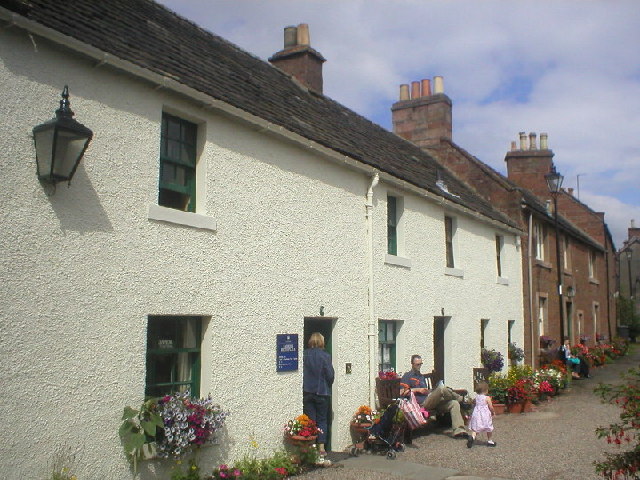
Barrie's Birthplace, Kirriemuir
©Richard Slessor, Public Common via Wikimedia Commons
Barrie's marriage was not a happy one and they had no
children. It is said that it was never
consummated. In 1895 they bought a
house in South Kensington, followed in 1900 by one overlooking Kensington
Gardens where Barrie would walk his St. Bernard, Porthos. [Maybe portrayed as Nana the nursemaid dog
for the Darling family.] It was during
these walks that he became acquainted with the Llewelyn-Davies family, Arthur
and Sylvia, nee Du Maurier, and their five sons, George, John, Peter, Michael
and Nicholas.
A firm friendship was established and following the deaths
of Arthur and Sylvia, within 3 years of each other, 'Uncle Jim' became guardian
and provided financial support for the family and his relationship with the
boys continued well beyond their childhood and adolescence. Sadly, Barrie lost the two boys to whom he
was closest. George was killed in
action in 1915 in the First World War, and Michael drowned in 1921 with a
friend at Sandford Lock, near Oxford.
Barrie and Mary divorced in 1909 following Mary's infidelity
with Gilbert Cannan, but he continued to support her financially, even after
she remarried, by giving her an annual allowance.
Barrie died of pneumonia in London on the 19th June
1938. He was buried at Kirriemuir,
next to his parents and two of his siblings, and his birth home is maintained
as a museum by the National Trust for Scotland.
Barrie gave the copyright of the Peter Pan works to Great
Ormond Street Hospital for Children in 1929.
Today, the Copyright, Designs & Patents Act 1988 in the UK means
that the hospital will continue enjoying the benefits of Peter Pan and Barrie's
gift for perpetuity.
Judie Weedon
26
CHILDHOOD LITERATURE
""Why in all those myst'ry tales we've
read, it's not been the police that found the murd'rers at all. It's been ordinary people same as you an' me
jus' usin' common sense an' picking up cigarette ends an' such like . . .
Tell you what it is," he said, warming to his theme,
"policeman have gotter be stupid 'cause of their clothes, I mean, all the
policemen's clothes are made so big that they've gotter be very big men to fit
'em an' big men are always stupid 'cause of their strength all goin to their
bodies 'stead of their brains. That
stands to reason, dun't it?""
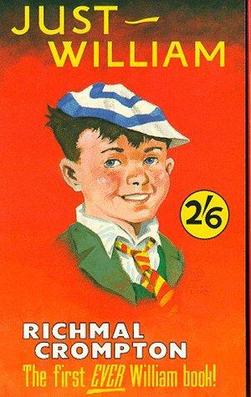
Just William - original cover
By Thomas Henry(1879-1962)
Public Domain, Link
The wise words of William Brown! William is the leader of a group of friends
- Ginger, Henry and Douglas, and his scruffy mongrel Jumble - who call
themselves the Outlaws. Stories of the
Outlaws usually start when they set out to do something - put on a play, collect
scrap metal for the war effort or look after Violet Elizabeth Bott [she of
"I'll scream and scream until I make myself sick", fame]. Somehow, the friends always get into trouble
and their well-meaning efforts often result in broken windows and hysterics
among Mrs. Brown's friends.
The irrepressible Just William is the
work of Richmal Crompton.
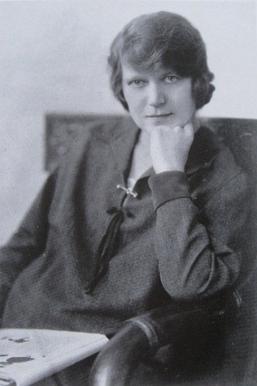
Hayes Farm, Devonshire 1534
By bartsbookshelf.co.uk
Fair use
Richmal attended St. Elphin's
Boarding School, for the daughters of the clergy. To further her chosen career as a school
teacher, she won a scholarship to Royal Holloway College, University of London,
graduating with a BA Honours degree in Classics in 1914. She took part in the Women's Suffrage
movement.
Following her degree, she returned to
St. Elphin's to teach Classics, moving in 1927 to Bromley High School, south
east London, where she began her writing career. She was an excellent and committed teacher
but in 1923 she contracted poliomyelitis resulting in losing the use of her
right leg and being confined to a wheelchair.
She gave up her teaching career and began to write full time. Sometime later, when she was in her forties,
Richmal suffered breast cancer resulting in a mastectomy.
Although she was an aunt and great aunt
to her brother John's family, she never married or had children of her own.
Her William stories. and other
literature, were extremely successful and three years after retiring from
teaching she was able to afford to have a house built, The Glebe, in Bromley
Common, for her mother and herself.
During the Second World War, in spite
of her disabilities, Richmal volunteered with the Fire Service.
She died in 1969 and her ashes are
interred at Eltham Cemetery and Crematorium.
Although she saw her real work as
writing adult fiction, none were as successful as the William books, some 39 in
all, which have sold over twelve million copies in the UK, been translated into
9 languages and adapted for films, stage plays and numerous radio and
television series.
Judie Weedon
28
CHILDHOOD LITERATURE
"Not long after, and while it was still
twilight, the grandfather also went to bed, for he was up every morning at
sunrise, and the sun came climbing up over the mountains at a very early hour
during these summer months. The wind
grew so tempestuously during the night, and blew in such gusts against the
walls, that the hut trembled and the old beams groaned and creaked.
Johanna Spyri with son
Bernhard Diethlem - 1856
Upload by Adrian Michael
Public domain, via Wikimedia Commons

Heidi Chapter 3C - "You can have that"
Johanna Spyri (1827-1901), ilustr. Jessie Willcox Smith 1863-1935derivative work: Wieralee
Public domain, via Wikimedia Commons
"Outside the moon was struggling with
dark, fast-driving clouds, which at one moment left it clear and shining, and
the next swept over it, and all again was dark. Just now the moonlight was falling through
the round window straight on to Heidi's bed.
She lay under the heavy coverlid, her cheeks rosy with sleep, her head
peacefully resting on her little round arm, and with a happy expression on her
baby face as if dreaming of something pleasant. The old man stood looking down on the
sleeping child until the moon again disappeared behind the clouds and he could
see no more, then he went back to bed."
Johanna Spyri's delightful story of
Heidi, the girl from the alps, is by far the most popular work of Swiss
literature. It has been translated from
German into 50 languages, been filmed more than a dozen times and more than 50
million copies of Heidi books have been sold world-wide. Johanna
Spyri, nee Heusser, was born in 1827 and raised in the small village of Hirzel,
southeast of Zurich.
Johanna Spyri - 1890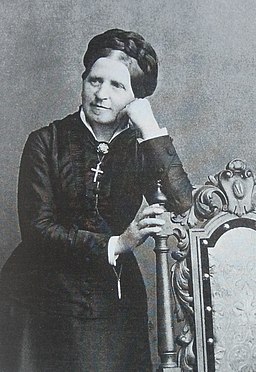
upload by Adrian Michael
Public domain, via Wikimedia Commons
Her choice to remain in Hirzel with her
parents might have been for safety as politically, these were turbulent times
in Switzerland with a short civil war, followed in 1847 by the foundation of a
modern, democratic, federal national state.Johanna married Johann Bernard
Spyri, a lawyer, journalist and workaholic, in 1852, when she was 25. He did not show much interest in his wife
and the marriage was not very happy.
During her pregnancy with her only
child, Bernard, she suffered from depression, which continued for several
years. Bernard sadly died early of
consumption at the age of 28, in 1884, the same year that his father also died.
It was a family friend who encouraged
Johanna to write and she published her first story in 1871.
From that date to 1901, she published
27 books and 4 booklets containing a total of 48 stories and novels. She had a rather critical view on
Switzerland's society in the late 19th century and today her works, apart from
the Heidi story, probably find more interest to historians than those
interested in literature. She had a
special interest in the situation of children and young women who at that time
were regarded as small, imperfect adults.
It was, therefore, quite revolutionary that she took sides with the
children as having their own world and their own needs differing widely from
the world of adults.
Johanna Spyri died in Zurich, where she
is buried, on the 7th July
1901.
Judie Weedon
37
CHILDHOOD LITERATURE

The Voyage of Doctor Dolittle
Hugh Lofting, Public domain, via Wikimedia Commons
Have you met the residents of
Puddleby-on-the-Marsh? Gub-Gub - the
pig, Jip - the dog, Chee-Chee - the monkey, Dab-Dab - the housekeeper duck,
Too-Too - the accountant owl, and Polynesia - the parrot? If not, you must also meet Cheapside - the
cockney sparrow, notorious for using bad language and resident of St. Edmund's
left ear on the statue at St. Paul's Cathedral, who visits with news and likes
to gossip. And, of course, the
Pushmi-Pullyu, the gazelle unicorn cross with two heads, who usually uses only
one head to talk, reserving the other for eating, allowing it to talk with its
mouth full!
These wonderfully named creatures are
the friends of Dr. Doolittle, as told in the books by Hugh Lofting.
Hugh John Lofting was born at
Maidenhead on the 14th January 1886, one of six children to English and Irish
Catholic parents. By the time he was
eight, he was boarding at Mount St. Mary's College in Derbyshire, before
studying civil engineering at the Massachusetts Institution of Technology in
the States, returning to England to complete his course at the London
Polytechnic.
A variety of jobs followed some of
which took him to Canada, West Africa and Cuba, as well as the States, where in
New York in 1912 he married Flora Small.
Having decided that engineering was not for him, he began writing
articles and short stories, but the outbreak of the First World War put this
career on hold.
In 1916 he joined the British Army as a
member of the Irish Guards, serving in France and Flanders. His children looked forward to receiving his
letters and wanted to know about his life in the trenches. However, he felt that to write about what he
was enduring was not suitable for children.
He had noticed that unlike wounded soldiers who were medically treated,
the war-employed animals were shot or discarded as no longer useful. Out of disgust for this treatment of
animals, Dr. Doolittle was born. This
doctor gave up treating humans and turned his attention to treating animals
which he felt was best achieved by learning their language. The illustrated stories were sent back home
to entertain his children, Elizabeth and Colin.

Hugh Lofting at a book signing - 1935
Los Angeles Times, CC BY 4.0
via Wikimedia Commons
Lofting was wounded in France in 1917,
discharged two years later and sent back to his family in America. Moving to Connecticut, he devoted his time
to writing.
The Story of Dr. Doolittle was
published in 1920, enthralling his readers, and a second book, The Voyages of
Dr. Doolittle, was published in 1923, winning critical acclaim and the Newberry
Medal Award.
In 1927 Flora died and the following
year Lofting married Katherine Harrower.
Sadly, just shortly after their wedding, Katherine caught flu and
died. Possibly as a result of these
losses, his own health began to decline and although he had been ready to put
Dr. Doolittle 'to bed', readers wanted more and he obliged.
In 1935 he married his third wife,
Josephine Fricker, and they moved to California where their son, Christopher,
was born. The outbreak of the Second
World War soured Lofting, which was reflected in his writing which became
rather 'dark'.
Hugh Lofting died in Santa Monica,
California, on the 26th September 1947, after a two-year illness. Despite taking up residency in the States,
he never became an American citizen, remaining a British subject throughout his
life.
In the 1970's, the 12 Dr. Doolittle
books fell out of favour and out of print, blacklisted for two decades because
some passages were considered racist.
In 1988, revised editions of the books were released.
In 1967, Dr. Doolittle took to the
screen, starring Rex Harrison, Samantha Eggar, Anthony Newley and Richard
Attenborough; a further adaptation was
filmed in 1998 with Eddie Murphy in the title role and another is currently in pre-production.
Judie Weedon
36
CHILDHOOD LITERATURE
"I knew something wonderful was going to happen, but I didn't think it was going to be this. Oh, my Daddy, my Daddy!"
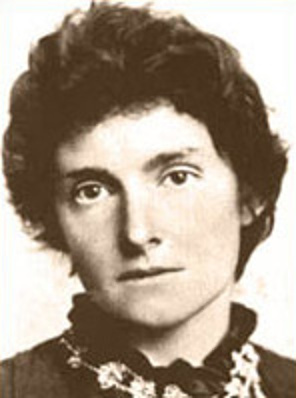
Edith Nesbit
Unknown source
Public domain, via Wikimedia Commons.
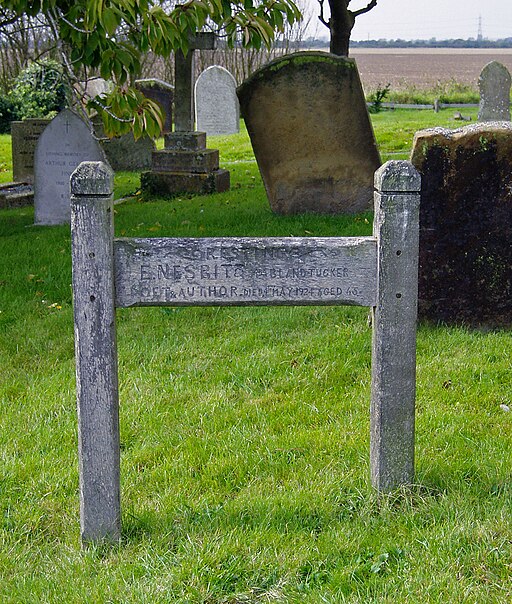
St Mary In The Marsh Churchyard
Ian Dunster CC BY-SA 3.0, via Wikimedia Commons
So ends The Railway Children, probably the best-known children's novel by Edith Nesbit, a political activist, who published more than 40 books for children, including novels, collections of stories and picture books.
.jpg)
The original 1906 The Railway Children
Edith Nesbit
Public domain, via Wikimedia Commons
Edith Nesbit was born in London in 1858. Her father, an agricultural chemist, died in 1862 and due to her sister Mary's ill health, with tuberculosis, the family were unsettled, not only living in various places in this country but also in France, Spain and Germany.
When Edith was 17 the family moved back to London, where at 18, she met and married Hubert Bland. Although their marriage was a troubled one, it survived until Hubert died in 1914. Bland engaged in several extra-marital affairs including one with Edith's friend, Alice Hoatson.
Edith had three children: Paul [1880-1940], Iris [1881-1950's] and Fabian [1885-1900], as well as adopting Rosamund and John, Bland's children by Alice Hoatson, who remained with them as a housekeeper and secretary.
Due to her success as a writer, the Blands were able to enjoy financial stability, and in 1899 the family moved to Well Hall, Eltham, a 3-storey house surrounded by orchards and farmland which was their home for 22 years.
Edith was a very gregarious and generous person, hosting parties at Well Hall for their many literary friends such as George Bernard Shaw, H.G. Wells and other members of the Fabian Society of which they were founder members.
Their son, Fabian, named after the Society, died in 1900 at the age of 15, following an operation at their home to remove his tonsils. The doctor, believing the operation to be successful, left, but Fabian never woke up from the anaesthetic. It later transpired that he had choked on his own vomit as a result of his parents forgetting that he was forbidden to eat for 24 hours before the operation. Edith was inconsolable and tried to overcome her grief, and possibly guilt, by writing, and in Five Children and It, it is Fabian's fictional alter ego Robert, mischievous, ingenious, adored who steals the limelight.
The First World War and Hubert's death in 1914 changed the family's fortunes but prior to moving to her beloved Kent, Edith found solace and happiness with the Captain of the Woolwich Ferry, Thomas Tucker, whom she married in 1917 at Woolwich. Together they built a home at St. Mary's Bay, Dymchurch, where in May 1924 Edith died.
Her final resting place is in St. Mary in the Marsh's churchyard, marked by a wooden grave marker made by Thomas. There is also a memorial plaque in the church. Thomas died eleven years later, with Edith's adopted daughter, Rosamund, at his side.
Judie Weedon
32
CHILDHOOD LITERATURE
_cover.jpg)
Black Beauty (1877) cover
Black_Beauty_(1877).djvu: Anna Sewellderivative work: Theornamentalist
Public domain, via Wikimedia Commons
"I hope you will grow up gentle and
good, and never learn bad ways;do your
work with a good will, lift your feet up well when you trot, and never bite or
kick even in play."
Narrated by a lively, gentle horse,
Black Beauty, as both the horse and book are called, has remained a children's
classic since it was first published in 1877, and earned a name and fame for
its author, Anna Sewell.
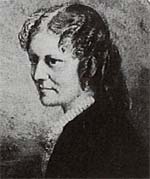
Anna Sewell
By Unknown author
www.educared.org.ar
Public Domain, Link
Anna Sewell was born in March1820 in
Great Yarmouth, a daughter for devout Quakers Philip and Mary Sewell, a
successful author of children's books.
Anna and her brother Philip were largely educated at home due to
financial constraints.
When she was only four, Anna slipped at
home severely damaging her ankle, which with another accident ten years later,
resulted in her being unable to stand without a crutch or walk any distance for
the rest of her life.Consequently, for
mobility, she would use horse-drawn carriages contributing to her love of
horses and concern for the humane treatment of all animals.In 1832 the family moved to Stoke Newington
and Anna, at the age of 12, attended school for the first time.
Over the years the family moved several
times;to Brighton, Lancing, Wick and
Bath, often in the hope of improving Anna's deteriorating health.
In her late teens, she and her mother
apparently left the Society of Friends to join the Church of England, although
they remained active evangelists.
In 1866, her brother Philip's wife died
leaving him with seven young children and the family moved to Old Catton, near
Norwich, to support him.It was here
that Anna began to write the manuscript of Black Beauty, often so weak and bed
ridden that writing was a challenge and she would often dictate the text to her
mother, or write snatches on slips of paper.
Anna, who never married or had
children, died of hepatitis or tuberculosis on the 25th April, 1878, only five
months after Black Beauty was published, but she lived long enough to know of
its initial success.
Although now considered a children's
classic, Black Beauty was originally written for those who worked with horses,
with the aim of inducing kindness and sympathy in their treatment.It is considered to have had an effect of
reducing cruelty to horses, particularly banning the painful use of bearing
reins.
Black Beauty, one of the top ten
best-selling novels for children, has
sold more than fifty million copies world-wide, and been adapted for film and
television many times.
Judie Weedon
30
CHILLDHOOD
LITERATURE
Daisy Ashford's The Young Visiters or
Mr Salteenas Plan gives a different meaning to childhood literature. It was written when she was 9 years old but
not actually published until 1919, preserving her juvenile spelling and punctuation
and with a Preface by J.M. Barrie.
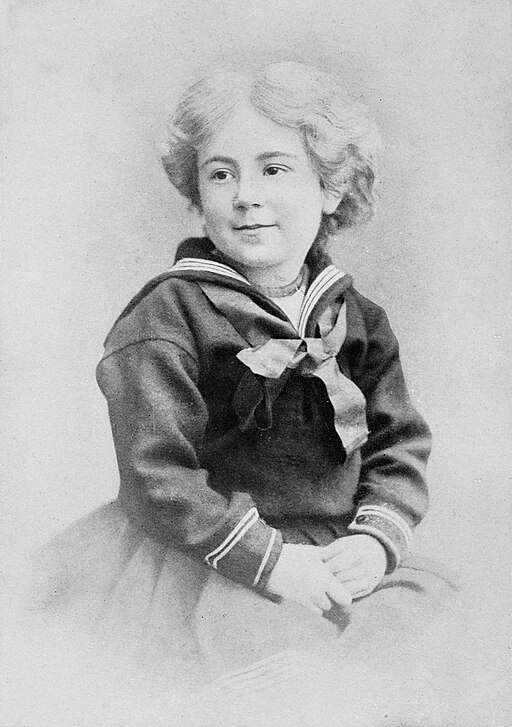
Daisy Ashford as a child
No picture credit
Public domain, via Wikimedia Commons
In The Young Visiters she tells of the
love triangle between Mr Salteena, "an elderly man of forty-two", and his
friends Ethel Montecue and Bernard Clark.
Ethel and Mr.Salteena visit Bernard's house:
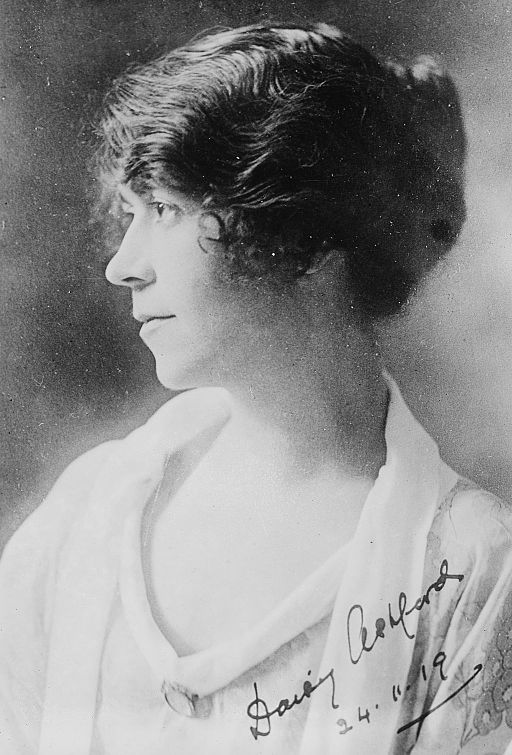
Daisy Ashford - 1919
George Grantham Bain Collection (Library of Congress), Public domain, via Wikimedia Commons
"Well said Mr Salteena lapping
up his turtle soup you have a very sumpshous house
Bernard. His friend gave a weary smile
and swallowed a few drops of sherry wine. It is fairly decent he replied with a bashful glance at Ethel
after our repast I will show you over the premisis. Many thanks said Mr Salteena
getting rather flustered over his forks."
Margaret Mary Julia Ashford, known as
Daisy, was born in Petersham, Surrey in April 1881, the daughter of Emma and
William Ashford. Education mainly at
home with her two younger sisters, Maria Veronica [Vera] and Angela Mary
[Angie], she dictated her first book, The Life of Father Swiney, to her father
when she was just four. It was
published in 1983.
From
1889 to 1904, the family lived in Lewes where she wrote The Young Visiters, as
well as several other stories, a play and another short novel or novella.
She stopped writing during her teenage
years and in 1904 moved with her family to
Bexhill and then London, where she worked as a secretary. During the First World War she ran a canteen
in Dover.
When published in1919, The Young Visiters
was an immediate success. It was
reprinted 18 times in the first year, dramatized for the stage in 1920, adapted
into a musical in 1968, filmed twice, in 1994 and for television in 2003.
In 1920 she married James Devlin and
settled in Norfolk running for a time, the Kings Arms Hotel in Reepham, later
farming at Hellesdon, Norwich, as well as bringing up their four children. James died in 1956.
Daisy did not write in later years but
in old age began an autobiography which she subsequently destroyed. She died, at Hellesdon, in January 1972 at
the age 90.
Judie Weedon
34
CHILDHOOD LITERATURE
"Who would wave a flag to be rescued if
they had a desert island of their own?"
John, Susan, Titty
and Roger [Walker] are staying on holiday at a farm in the Lake District.Nancy and Peggy [Blackett] live nearby. When they meet they agree to join forces
against a common enemy, the Blackett's uncle James, whom they call Captain Flint. So, begins Swallows and Amazons and the
sequels that follow, telling the tales of outdoor adventures - sailing,
camping, fishing, exploration and piracy - of the two families.
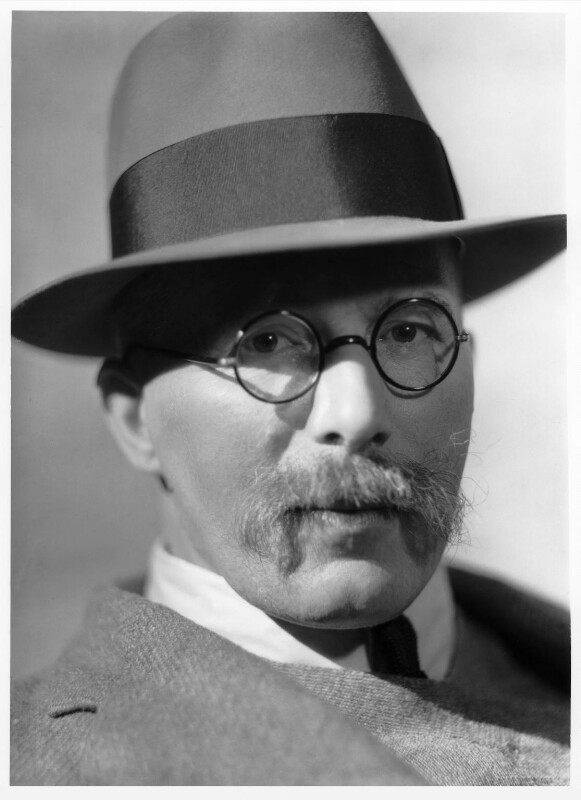
Arthur Ransome
by Howard Coster
half-plate film negative, 1932
Transferred from Central Office of Information, 1974
NPG x12267
© National Portrait Gallery, London
Licenced under CC BY-NC-ND 3.0
Written by Arthur Mitchell Ransome and
published in 1930, Swallows and Amazons was followed by Swallowdale
[1931], Peter Duck [1932], Winter Holiday [1933], Coot Club [1934], Pigeon Post
[1936], We Didn't Mean to Go to Sea [1937], Secret water [1939], The Big Six
[1940], Missee Lee [1941], The Picts and the Martyrs
[1943], Great Norther [1947] and unfinished, Coots in the North.
Arthur Ransome was born in Leeds in
1884, the eldest of four children - 2 sisters and a brother, who was killed in
the First World War in 1918. He was
educated at Windermere and Rugby. Due
to poor eyesight, lack of athletic skill and limited academic achievement,
schooling was not an enjoyable experience.
In 1902, he abandoned a chemistry degree to become a publisher's office boy
in London, using this time to practice writing and producing in 1907 his
significant first of many books.
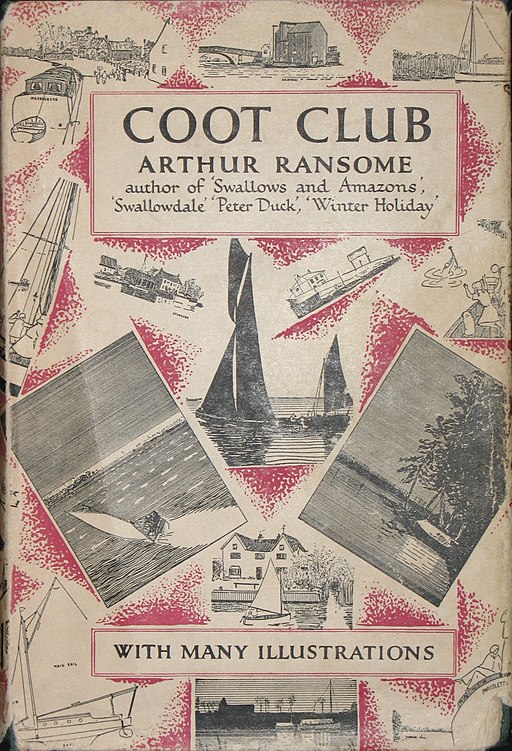
Arthur Ransome's 1934 novel, Coot Club
wwoods, CC BY-SA 3.0, via Wikimedia Commons
In 1909, he married Ivy Constance
Walker and they had one daughter, Tabitha.
Not a happy marriage, Ivy objected to the amount of time Arthur spent
writing and in 1913, to escape, he left Ivy and Tabitha and went to
Russia. Here he was ideally placed to
observe and report on the Russian Revolution, knowing many of the leading
Bolsheviks, including Lenin, Radek, Trotsky and
Trotsky's secretary Evgenia Shvelpina. These friendships led to persistent but
unproved accusations that he was a spy for both the Bolsheviks and Britain.
In 1924, he divorced Ivy and married Evgenia, returning to England to live in the Lake
District. He was, in the late 1920's, a
foreign correspondent and well-respected angling columnist for the Manchester
Guardian, before he began writing Swallows and Amazons and its successors.
The first edition was illustrated by
Steven Spurrier but Ransome
did not like his style and so it was published without illustrations. Spurrier was
followed by Clifford Webb but after Ransome successfully illustrated Peter Duck
himself, he decided to do his own illustrating for all the books, including
those already published.
Arthur Ransome died in June 1967 and he
and Evgenia are buried together at St. Paul's Church,
Rusland, in the Lake District. Interestingly, his sister's children,
when at home in Leeds, shared a governess with their second cousin, Peter
Middleton, grandfather of Catherine, Duchess of Cambridge. A second film - the first in 1974 - of
Swallows and Amazons was released in August 2016.
Judie Weedon
22
CHILDHOOD LITERATURE
"Nothing in the world is quite as adorably
lovely as a robin when he shows off and they are nearly always doing it."
And it
was the robin who showed them the way.
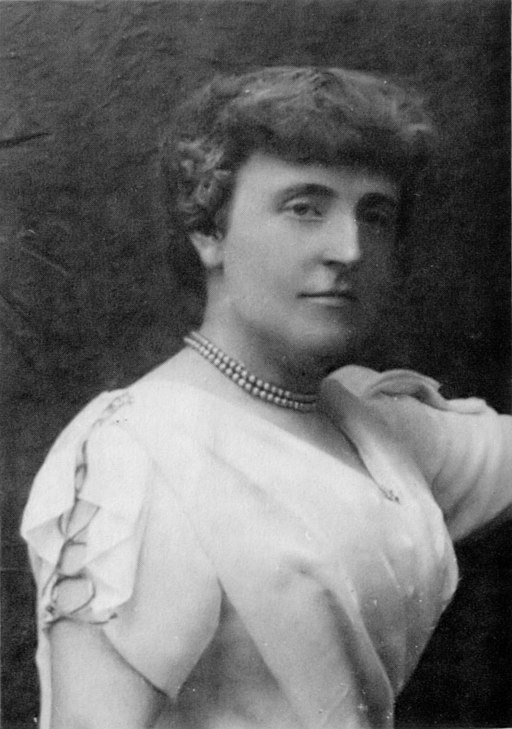
Frances Burnett
Herbert Rose Barraud (1845-1896)
Public domain, via Wikimedia Commons
The
Secret Garden by Frances Hodgson Burnett was published in 1911. Set in England, it is one of Burnett's most
popular novels and is considered a classic of English children's
literature. Several stage and film
adaptations have been made.
Frances
Eliza Hodgson-Burnett [24.11.1849-29.10.1924]
was a British-American novelist and playwright, best known for the three
children's novels, Little Lord Fauntleroy, A Little Princess and the Secret
Garden. She was born in Cheetham,
Manchester. After her father died in
1852, the family fell on hard times and in 1865 they emigrated to the
Knoxville, Tennessee, where Frances began writing to help earn money, publishing stories from the age of 19.
Her
mother died in 1870 and two years later Frances married Swan Burnett, a medical
doctor. For two years the couple lived
in Paris where their two sons were born, before returning to America, to
Washington DC. It was here that she
began writing her novels for both children and adults.
Burnett
lived a lavish lifestyle, enjoying a social life as well as making frequent
trips to England. In the 1980's she
bought a house here, which is where she wrote The Secret Garden.
Sadly,
her oldest son, Lionel, died of tuberculosis in 1890, and this brought on a
relapse of the depression she had struggled with for most of her life. She divorced Swan in 1898, married Stephen
Townsend in 1900 and divorced him two years later.
In later
live she settled in Nassau County, Long Island, where she died in 1924.
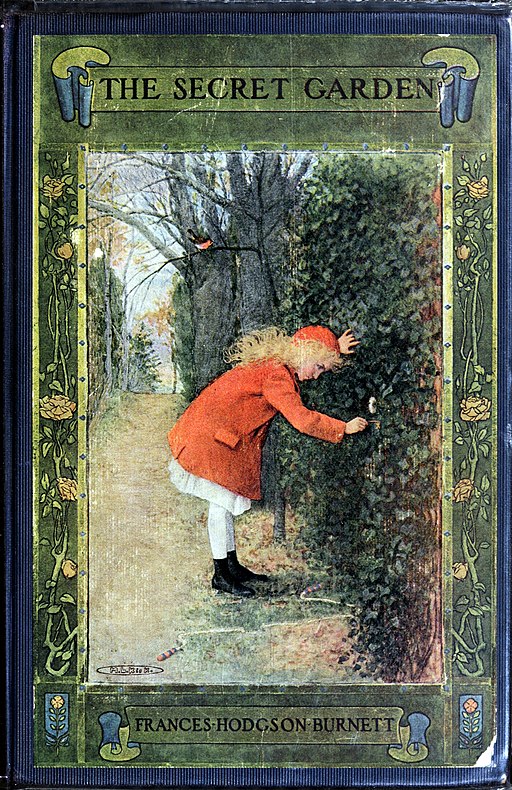
Illustrator: Maria Louise Kirk
Frances Hodgson Burnett
Public domain, via Wikimedia Commons
In 1936,
a memorial sculpture by Bessie Potter Vennoh, was erected in her honour in
Central Park's Conservatory Garden. The
statue depicts her two Secret Garden characters, Mary and Dickon.
Bessie Potter Vennoh [17.8.1872] born in St. Louis was a sculptor best known for her small bonzes, mostly of domestic scenes and for her garden fountains. She died in New York in 1955.
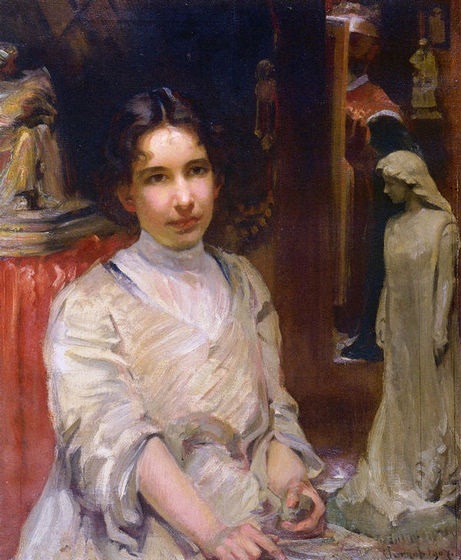
Bessie Potter Vonnoh
Robert Vonnoh, Public domain, via Wikimedia Commons
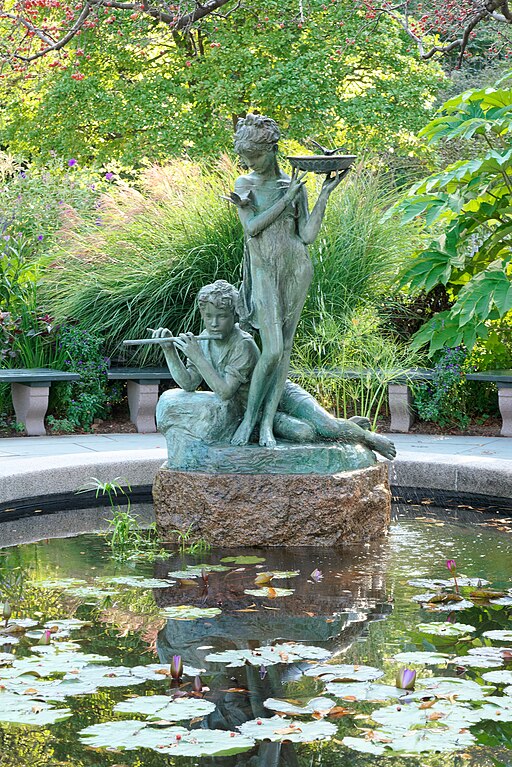
Burnett Memorial Fountain, Conservatory Garden
Central Park, New York City
Jakub Halun CC BY 4.0
via Wikimedia Commons
Judie Weedon
19
CHILLDHOOD
LITERATURE
"Matthew encountered the stationmaster
locking up the ticket office preparatory to going home for supper, and asked
him if the five-thirty train would soon be along. "The five-thirty train has been in and gone
half an hour ago," answered that brisk official. "But there was a passenger dropped off for
you - a little girl. She's sitting out
there on the shingles.
"I'm not expecting a girl," said
Matthew blankly, "It's a boy I've come
for. He should be here." The stationmaster whistled. "Guess there's some mistake," he said."
So, Anne Shirley finds herself at Green
Gables with Matthew and Marilla Cuthbert.
Anne of Green Gables was the first novel
by Canadian author L.M. Montgomery.
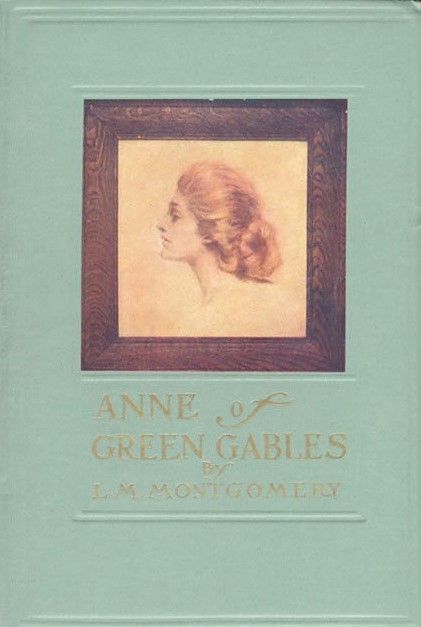
George Fort Gibbs (1870-1942)
(Note: M. A. & W. A. J. Claus did not illustrate the cover)
Public domain, via Wikimedia Commons
Lucy Maud Montgomery was born on Prince
Edward Island on the 30th November 1874.
Sadly, her mother died when she was only 21 months old and her father,
stricken with grief, gave custody to her maternal grandparents. Her early life was very lonely and
Montgomery credits this period in which she created many imaginary friends to
cope with her loneliness, for developing her creativity.
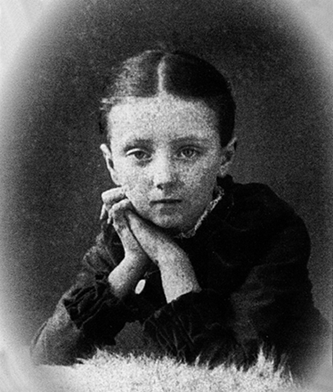
Lucy Maud Montgomery, 1884 (age 10)
Public domain, via Wikimedia Commons
Anne of Green Gables was published in
1908 and was an immediate success, and this was followed by a further four
books about Anne, reflecting a lot of her own life - at college in
Charlottetown and working as a teacher in various Prince Edward Island
schools. She stopped writing about Anne
around 1920, saying that she had tired of the character, but returned some 15
years later to write Anne of Windy Willows and Anne of Ingleside.
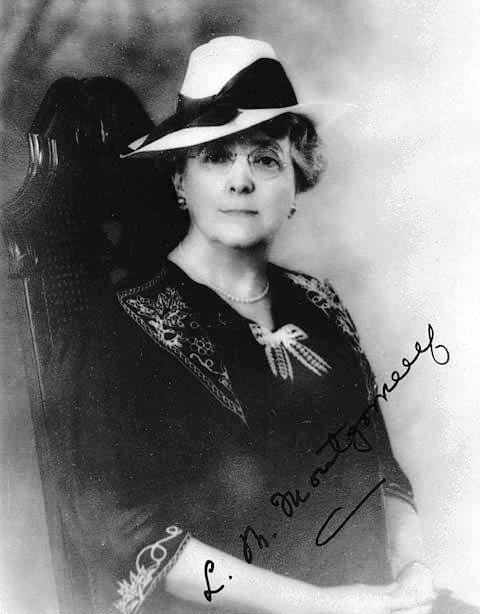
Lucy Maud Montgomery
Public domain, via Wikimedia Commons
As a fashionable young woman with
'slim, good looks', she attracted many suitors but did not marry until
1911. With her husband, Ewen Macdonald
[1870-1943], a Presbyterian Minister, she moved to the Manse in Leaskdale,
where she wrote her next eleven books.
They had three sons, but sadly the second was still born. Coping with the duties of church life,
motherhood and her husband's deteriorating health, Montgomery suffered several
bouts of depression.
She was honoured as the first female in
Canada to be made a fellow of the Royal Society of Arts in England, and was
invested with an O.B.E. in 1935.
She died on the 24th April, 1942, and was
buried at the Cavendish Community Cemetery.
It has been said that perhaps she took her own life.
During her lifetime she published 20
novels, over 500 short stories, an autobiography and a book of poetry.
Biographies of her life make interesting
reading as information regarding her life often differs.
There have been many films and
serialisations of Anne's story with a current new 9-episode one on Netflix,
which has received good reviews and although it mainly stays true to the book,
purists will not be happy that a bit has been added!The point was made that at that period in
history, orphans sent to a farm would often not have been treated well.
Judie Weedon
27
CHILDHOOD LITERATURE
"There is nothing - absolutely nothing - half so much worth doing as simply
messing about in boats."
"After all, the best part of a holiday is perhaps not so much to be resting
yourself, as to see all the other fellows busy working."
"The clever men at Oxford Know all that there is to be knowed. But they none
of them know one half as much As intelligent Mr. Toad."
Kenneth Grahame would never have believed that his delightful account of the antics of Ratty, Mole, Badger and Toad would still be a literary classic more than a hundred years after he scribbled them down, having been rejected by publishers several times before The Wind in the Willows was finally published in 1908. Toad of Toad Hall, as it began, was never intended to be a book, the character invented as a distraction to entertain his troubled only son.

First edition cover - The Wind in the Willows
W. Graham Robertson/Kenneth Grahame
Public domain, via Wikimedia Commons
Kenneth Grahame was born on the 8th March 1859 in Edinburgh. After his mother died of puerperal fever when he was five, he, his brothers Willie and baby Roland, and sister Helen were given into the care of their grandmother Ingles who lived in Cookham, Berkshire, where they were introduced to the riverside and boating by their uncle, David, Curate at Cookham Dean Church.
An outstanding pupil at St. Edward's School, Oxford, Grahame wanted to go to Oxford University but was unable to do so due to the cost and was instead sent to work for the Bank of England. He retired as its Secretary in 1908 due to ill health, possibly the result of a political shooting incident when he was shot at three times, all shots missing.
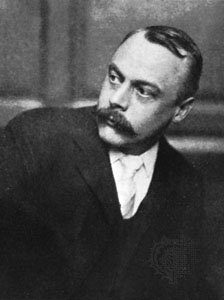
Kenneth Grahame
Public domain, via Wikimedia Commons
He married Elspeth Thomson in 1889. Their only child, Alastair, born in 1900, was sadly blind in one eye and suffered health problems all his life, committing suicide whilst an undergraduate at Oxford, two days before his 20th birthday.
There is a ten-year gap between Grahame's penultimate book and the publication of The Wind in the Willows. The wayward and headstrong nature he saw in Alastair he turned into the swaggering Mr. Toad. Ratty was inspired by his good friend and writer, Sir Arthur Quiller-Couch.
Despite its success, a sequel was never attempted. The book is beautifully illustrated by E.H. Shepard, OBE, MC, [1879-1976], illustrator of Winnie the Pooh and other books by A.A. Milne.
Grahame died in Pangbourne, Berkshire, in 1932 and is buried in Holywell Cemetery, Oxford. His epitaph, written by his cousin Anthony Hope - also a successful author - reads:
-
To the beautiful memory of Kenneth Grahame, husband
of Elspeth and father of Alastair, who passed the river on the 6th of July, 1932, leaving childhood and literature
through him the more blest for all time.
Judie Weedon
25
CHILDHOOD LITERATURE
"Christmas won't be Christmas without any presents," grumbled Jo, lying on the rug.
"It's so dreadful to be poor!" sighed Meg, looking down at her old dress.
"I don't think it's fair for some girls to have plenty of pretty things, and other girls nothing at all," added little Amy, with an injured sniff.
"We've got Father and Mother, and each other," said Beth contentedly from her corner.
So begins the story of Meg, Jo, Beth and Amy March, Little Women. Published in 1868, it remains today as one of the most read and re-read novels enjoyed by young girls of 9 to 90!
It follows the lives of the four sisters through to adulthood, dealing with the strains of growing up and finding themselves in different situations.
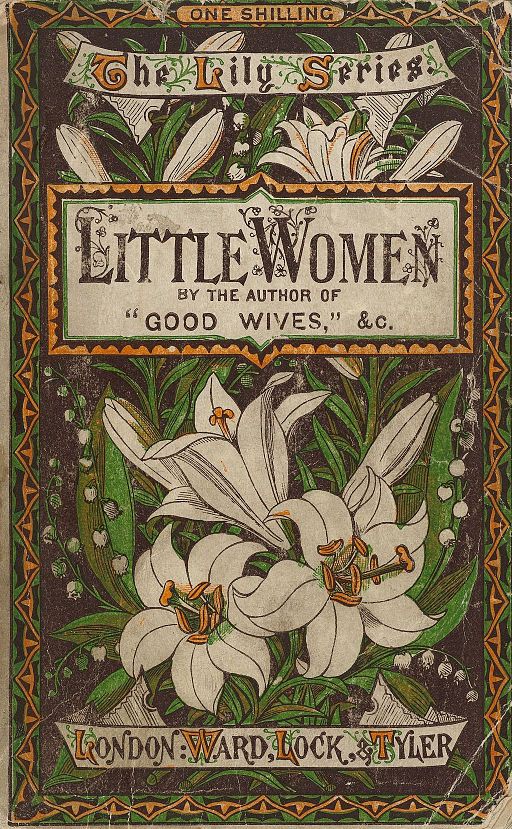
1878 English edition of Little Women
by Louisa May Alcott
Houghton Library
Public domain, via Wikimedia Commons
Written by Louisa May Alcott, it is loosely based on her life and that of her three sisters, Abigail, Anna and Elizabeth, and her parents Abigail and Amos Alcott. The family suffered from financial difficulties and Louisa worked to help support the family from an early age, but also found an outlet in writing for which she received critical success and sometimes writing under the pen name of A.M. Barnard, writing novels for young adults.
Born in Philadelphia in 1832, she was an abolitionist and a feminist and unlike the characters in her books, never married, She died in Boston at the early age of 55 in 1888.
Little Women was followed in 1871 by Good Wives, Little Men, and in 1886 by Jo's Boys, none of the books receiving quite the same acclaim.
The book has been adapted six times for film; four television series have been made, as well as a musical version and even an opera version in America in 1998.

Louisa May Alcott, c. 1870
George Kendall Warren (d. 1884);
restored by Adam Cuerden
Public Domain, via Wikipedia Commons
Judie Weedon
24
QUOTES
FROM CHILDREN'S BOOKS EVERY ADULT
SHOULD
KNOW!
Peter and Wendy
Margaret Ogilvy (1912)
_(14781659944)_(cropped).jpg)
Internet Archive Book Images
No restrictions
via Wikimedia Commons
'Promise me you'll remember, you are BRAVER than you believe, STRONGER than you seem, and SMARTER than you think.'
A.A. Milne - Winnie the Pooh
'A person's a person, not matter how small.' Dr. Seuss
'No act of kindness, not matter how small, is ever wasted.'
Aesop - The Lion and the Mouse
'How lucky I am to have something that makes saying goodbye so hard.'
A.A. Milne - Winnie the Pooh
'The true courage is in facing danger when you are afraid.'
L. Frank Braum - The Wizard of Oz
'If you have good thoughts they will shine out of your face like sunbeams and you will always look lovely.'
Roald Dahl - The Twits

Ernest Howard Shepard (illustrator), Public domain, via Wikimedia Commons

Ernest Howard Shepard (illustrator), Public domain, via Wikimedia Commons
'"Sometimes," said Pooh, "the smallest things take up the most room in your heart."'
A.A. Milne - Winnie the Pooh
'The moment where you doubt whether you can fly, you cease for ever being able to do it.'
J.M. Barrie - Peter Pan
'"Why did you do all that for me?" he asked, "I don't deserve it. I've never done anything for you."
"You have been my friend" replied Charlotte. "that in itself if a tremendous thing."'
E.B. White - Charlotte's Web
'Piglet: "How do you spell love/"
Pooh: "You don't spell it, you feel it."
A.A. Milne - Winnie the Pooh
'There's no place like home.'
L. Frank Braum- The Wizard of Oz
The Wizard of Oz Jack Haley
Tin Man

MGM, Public domain
via Wikimedia Commons
Judie Weedon
37
